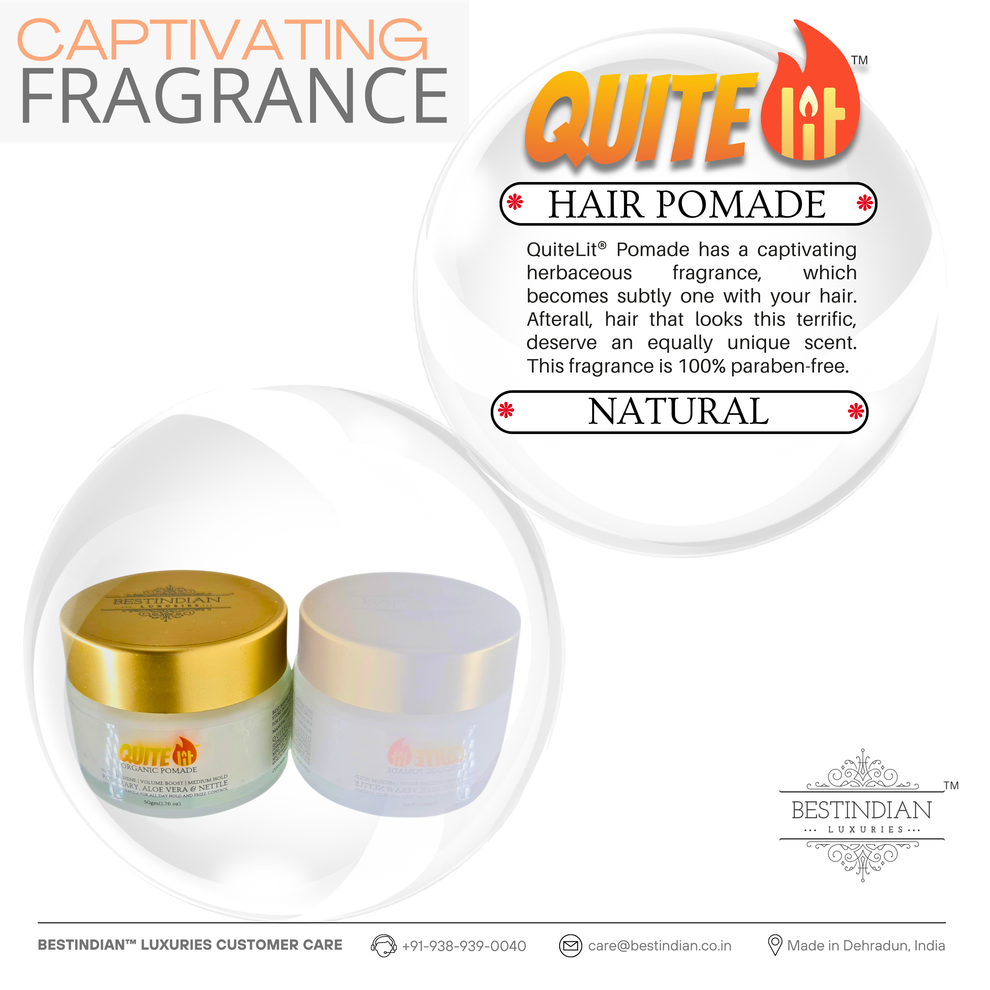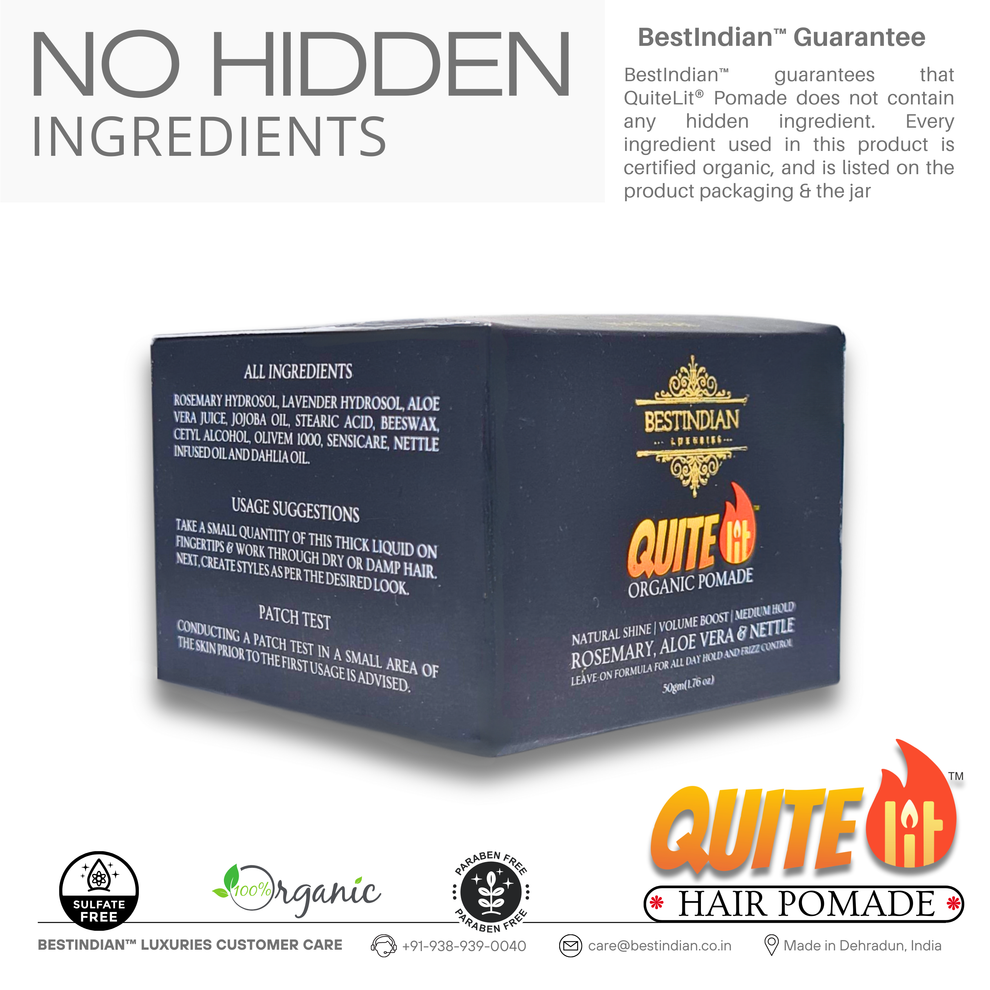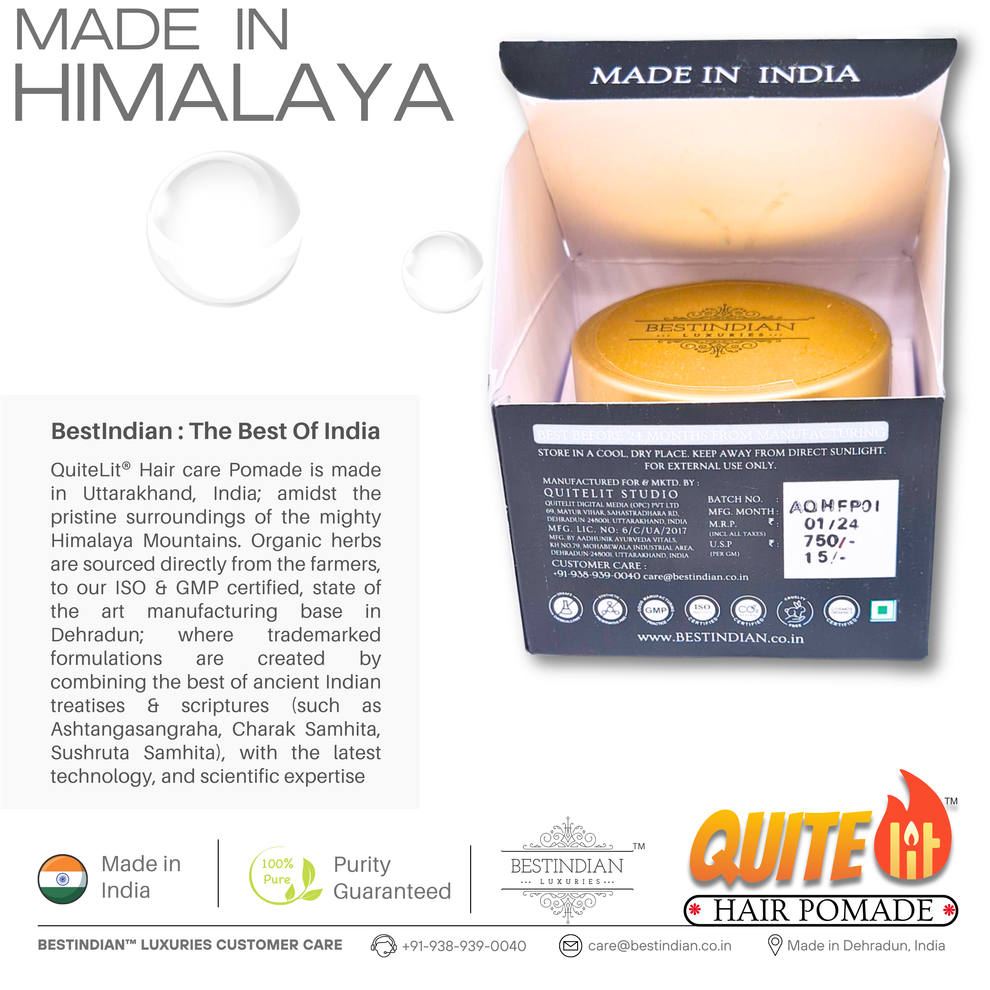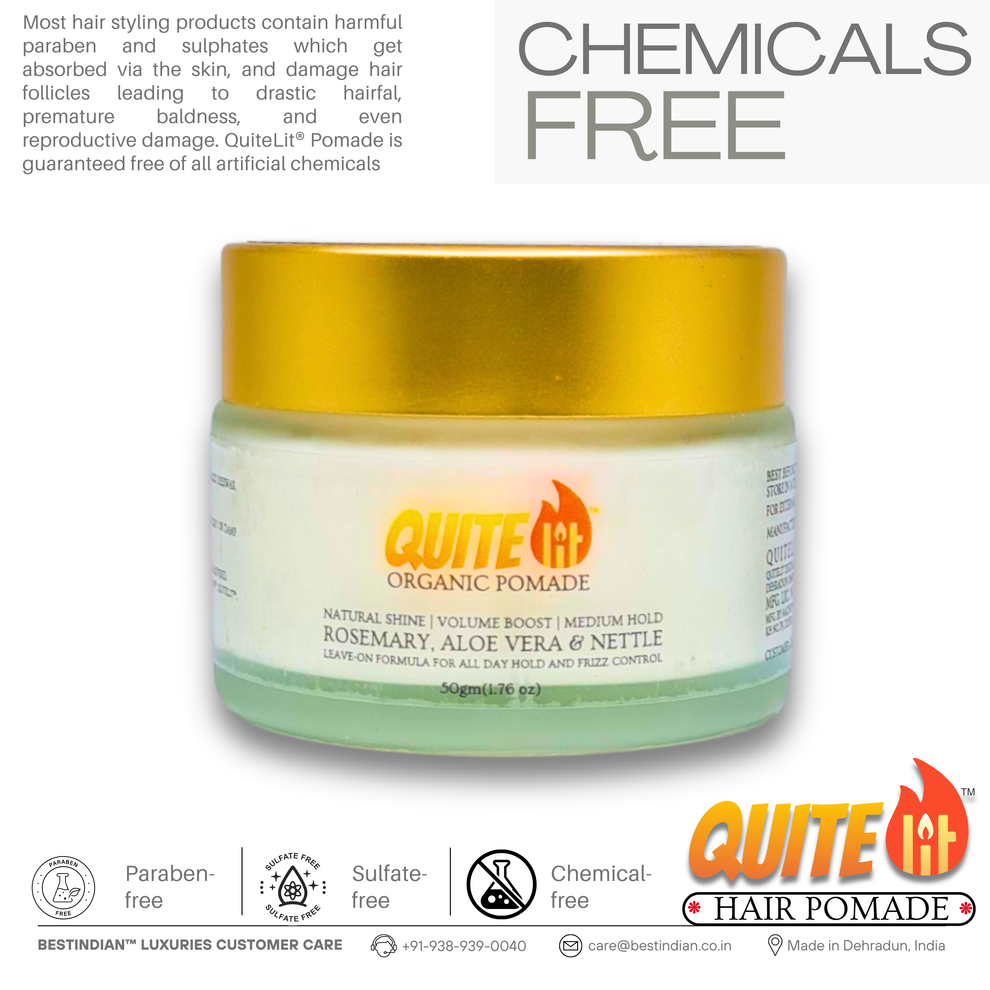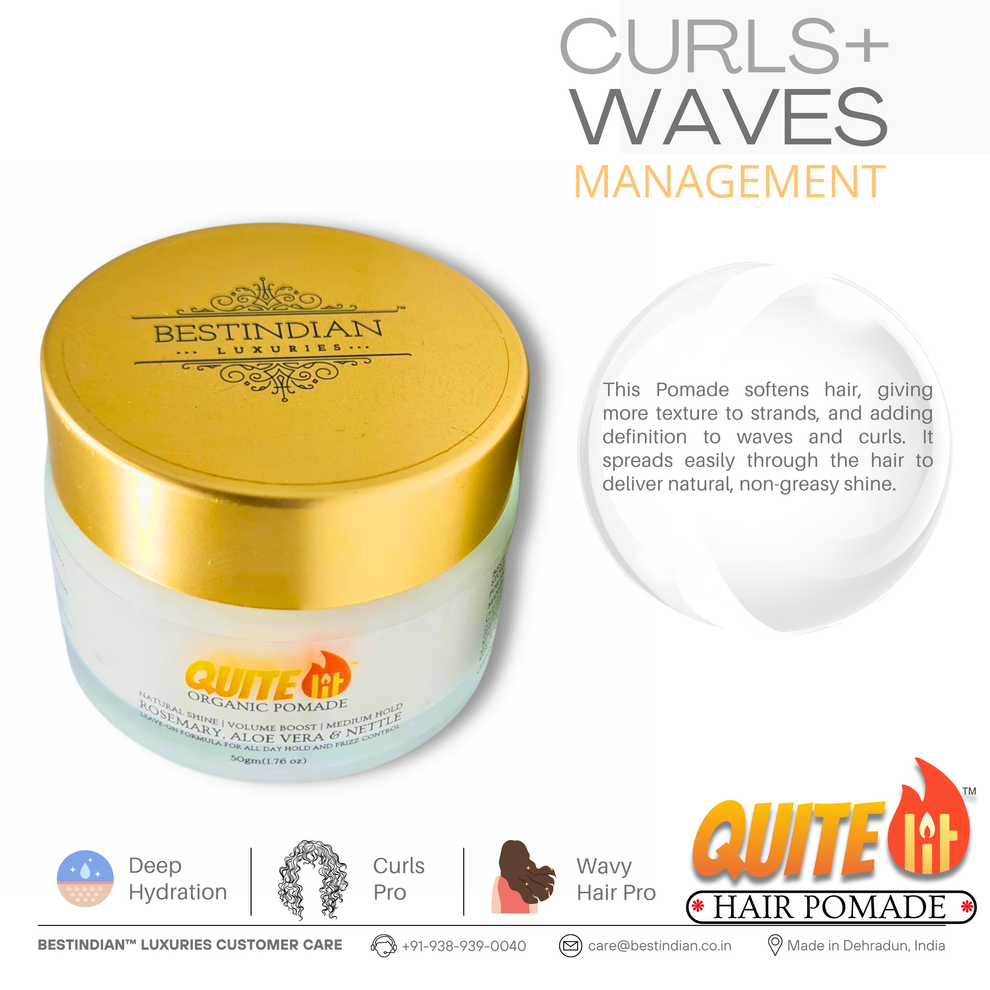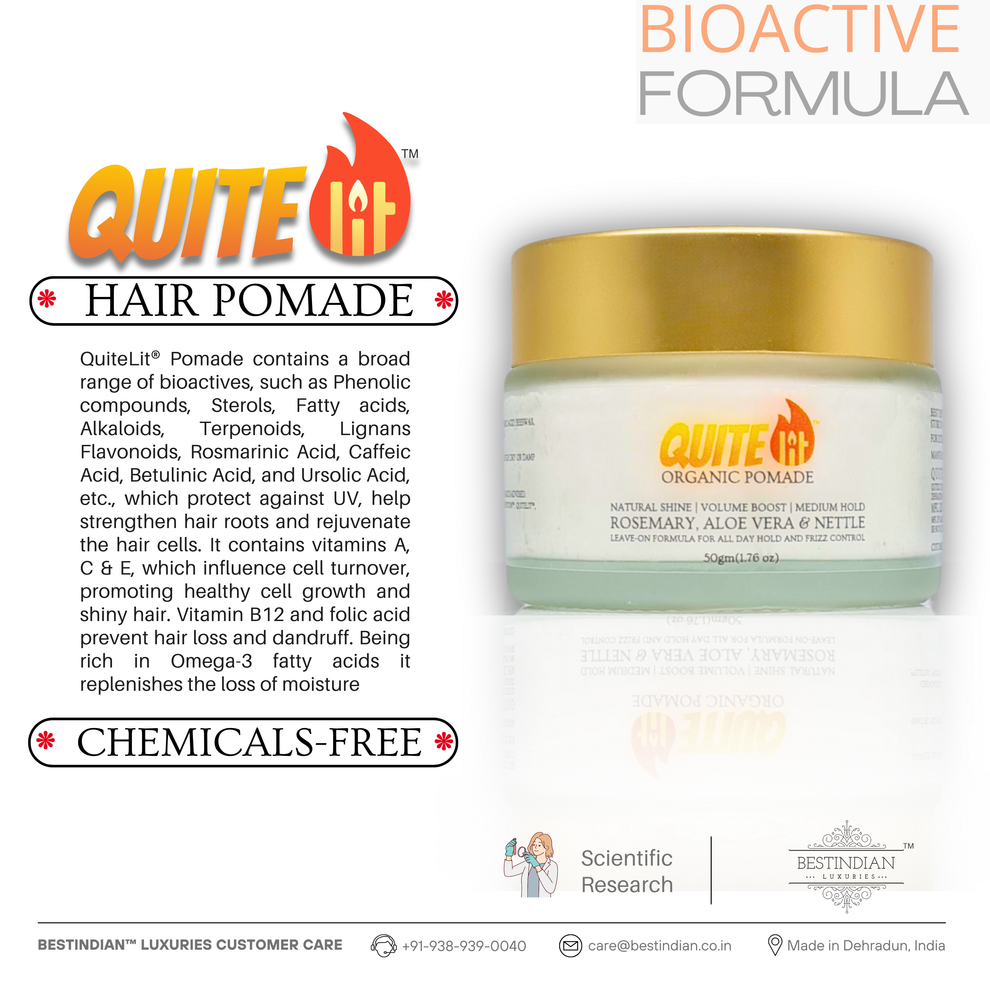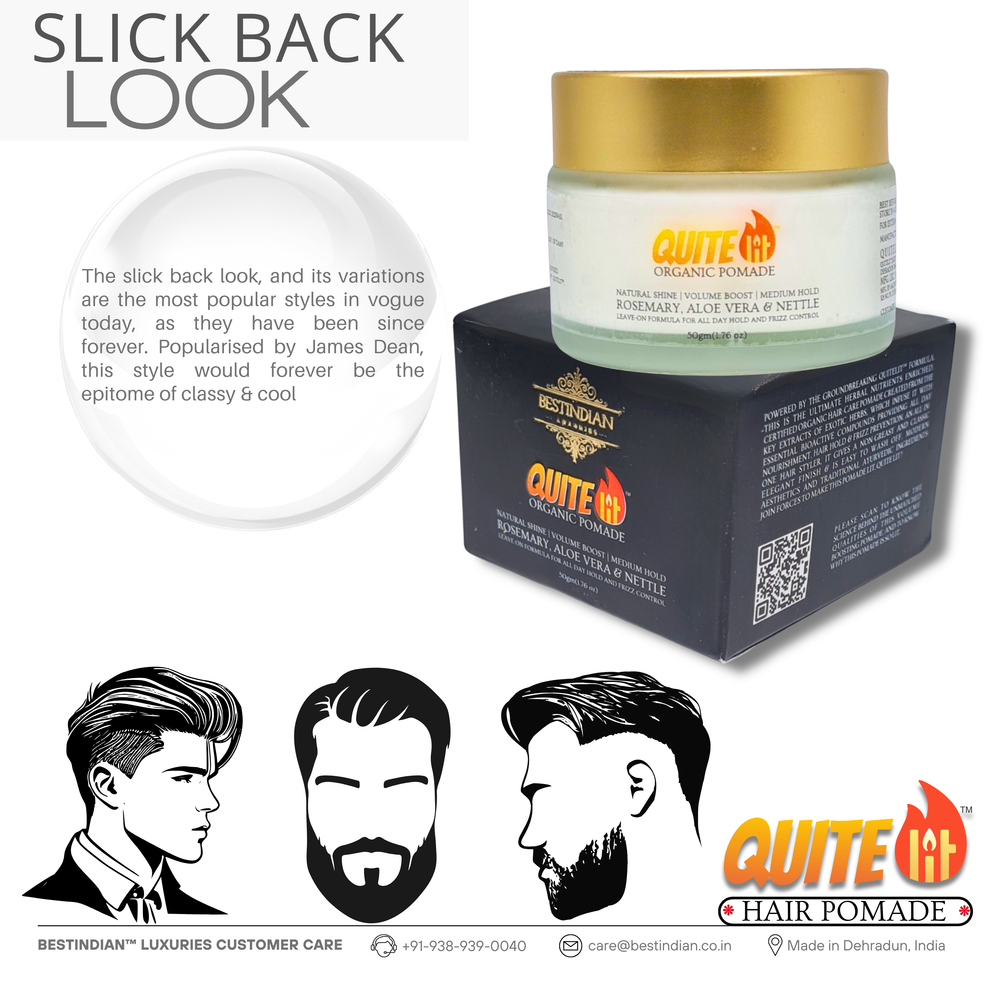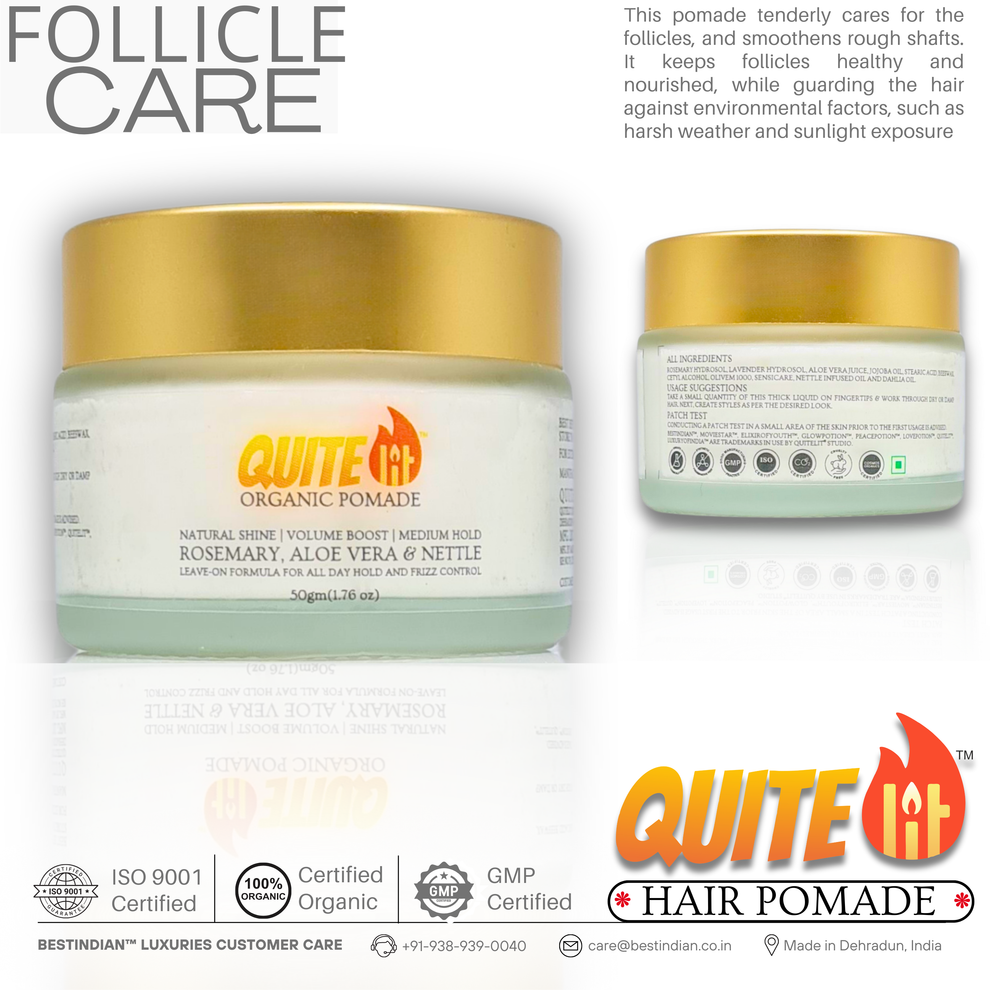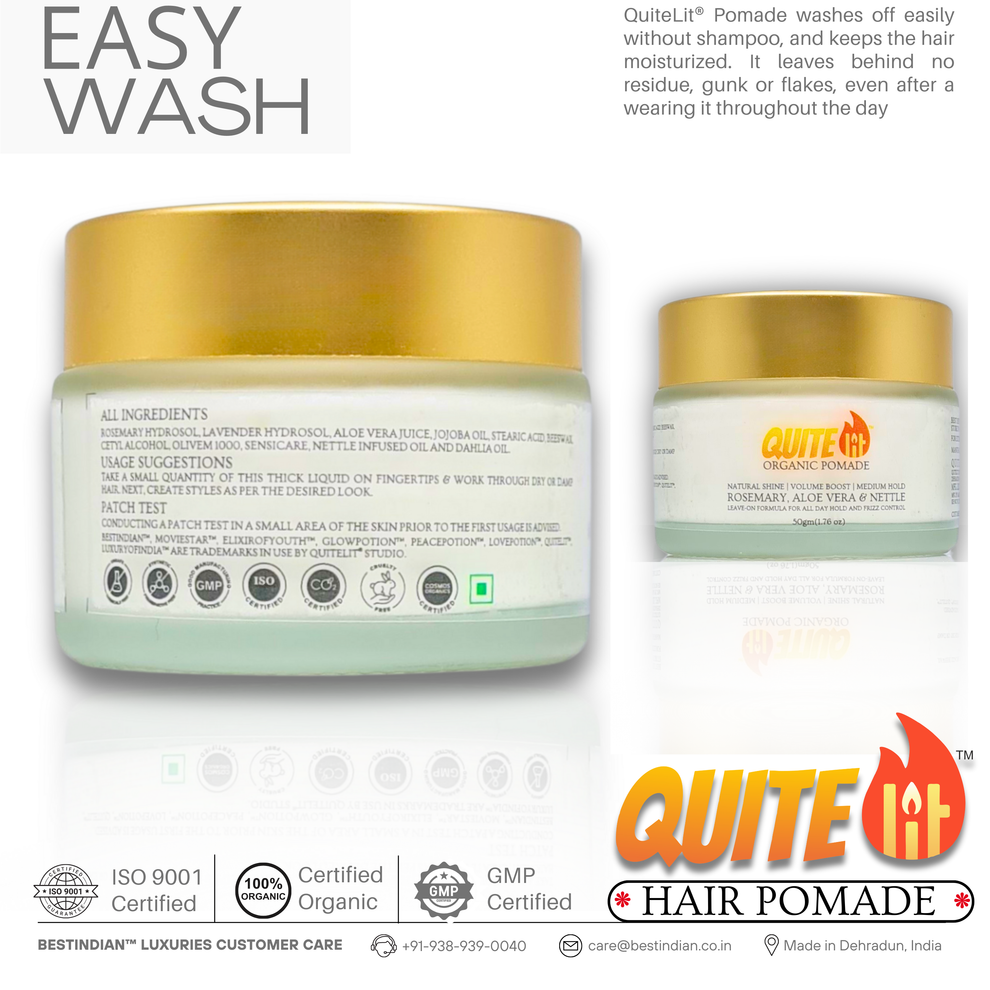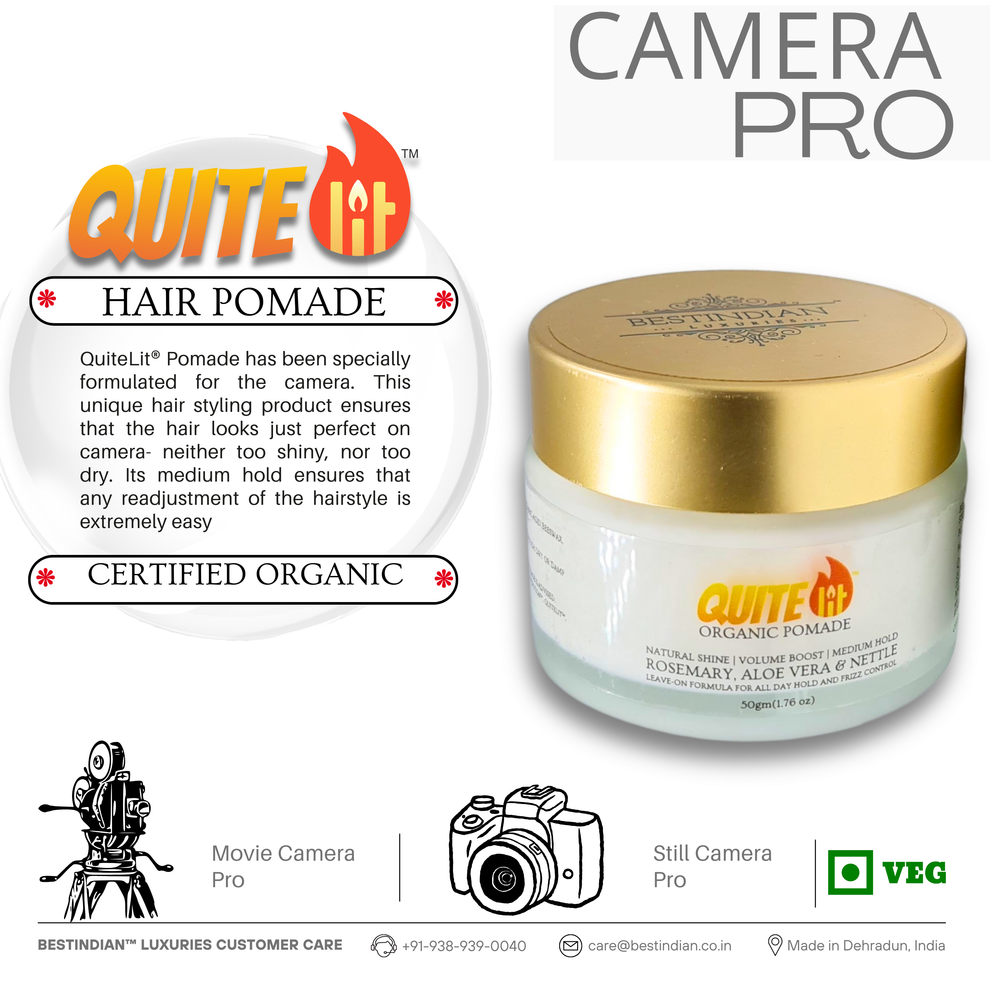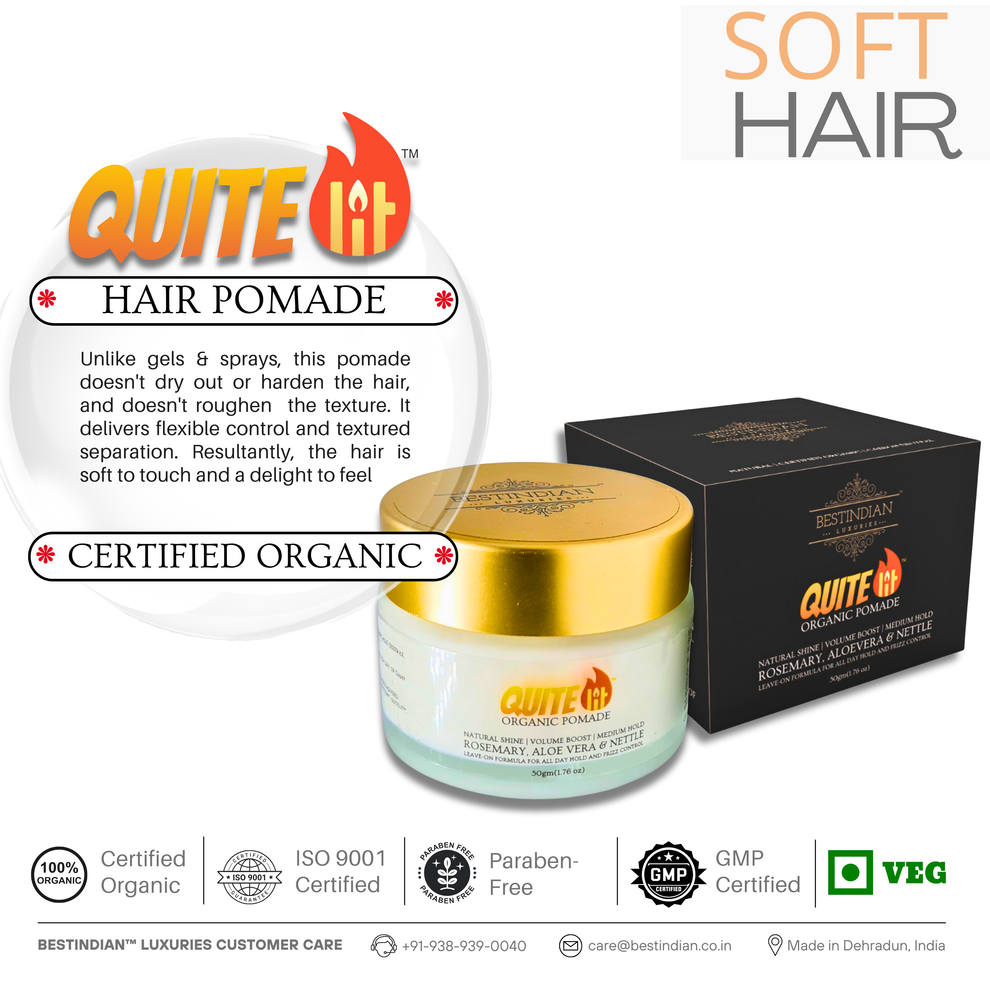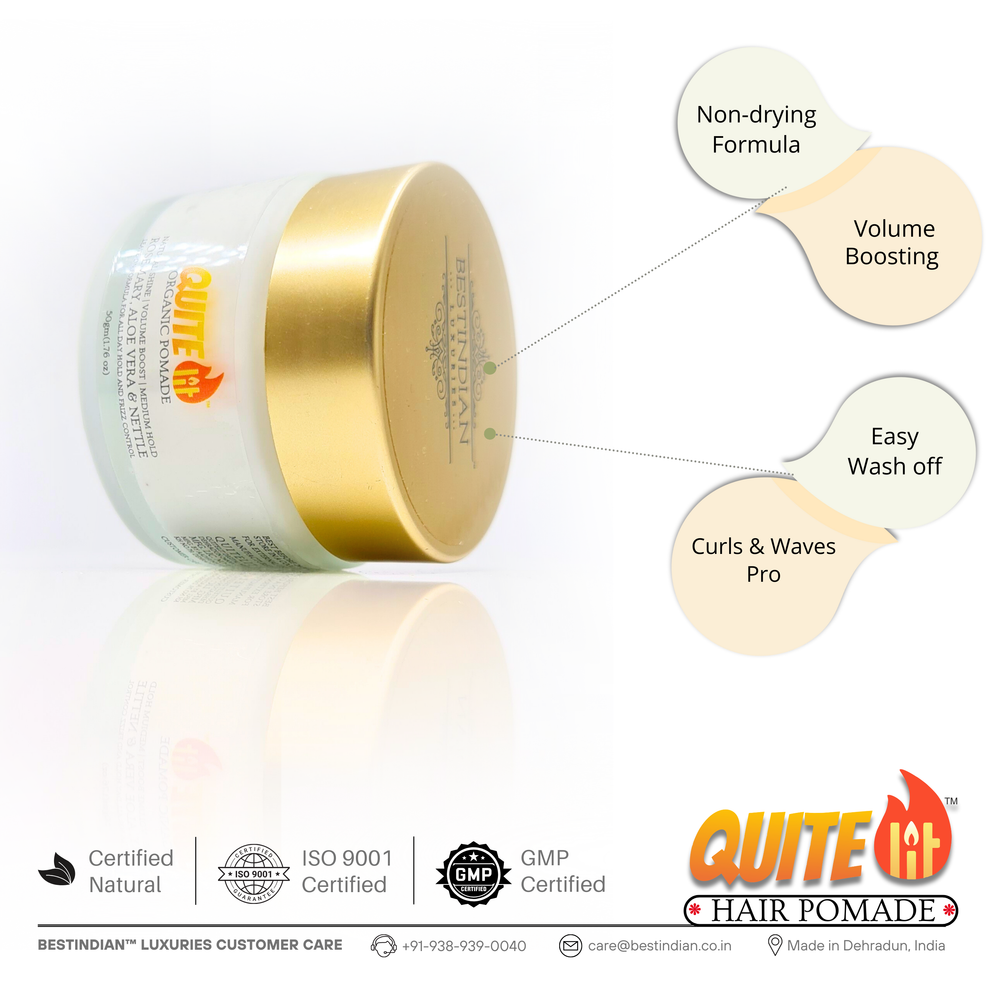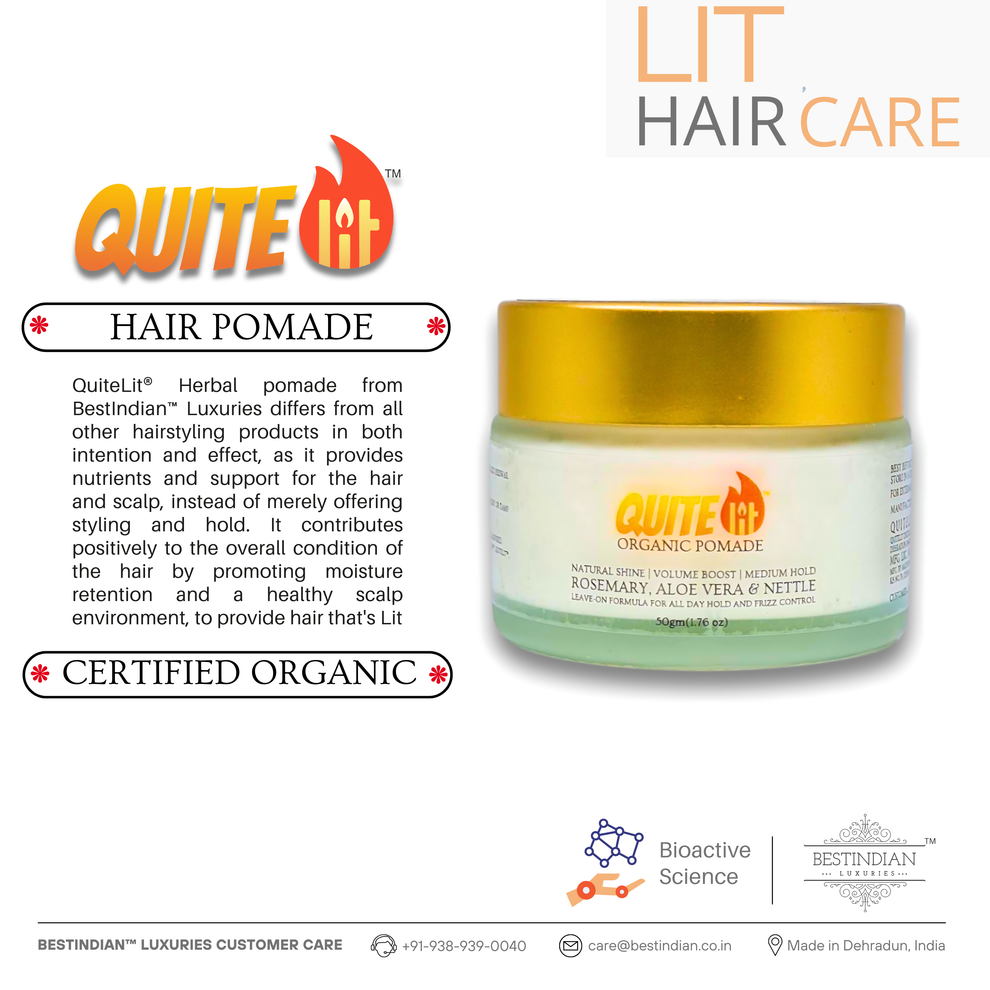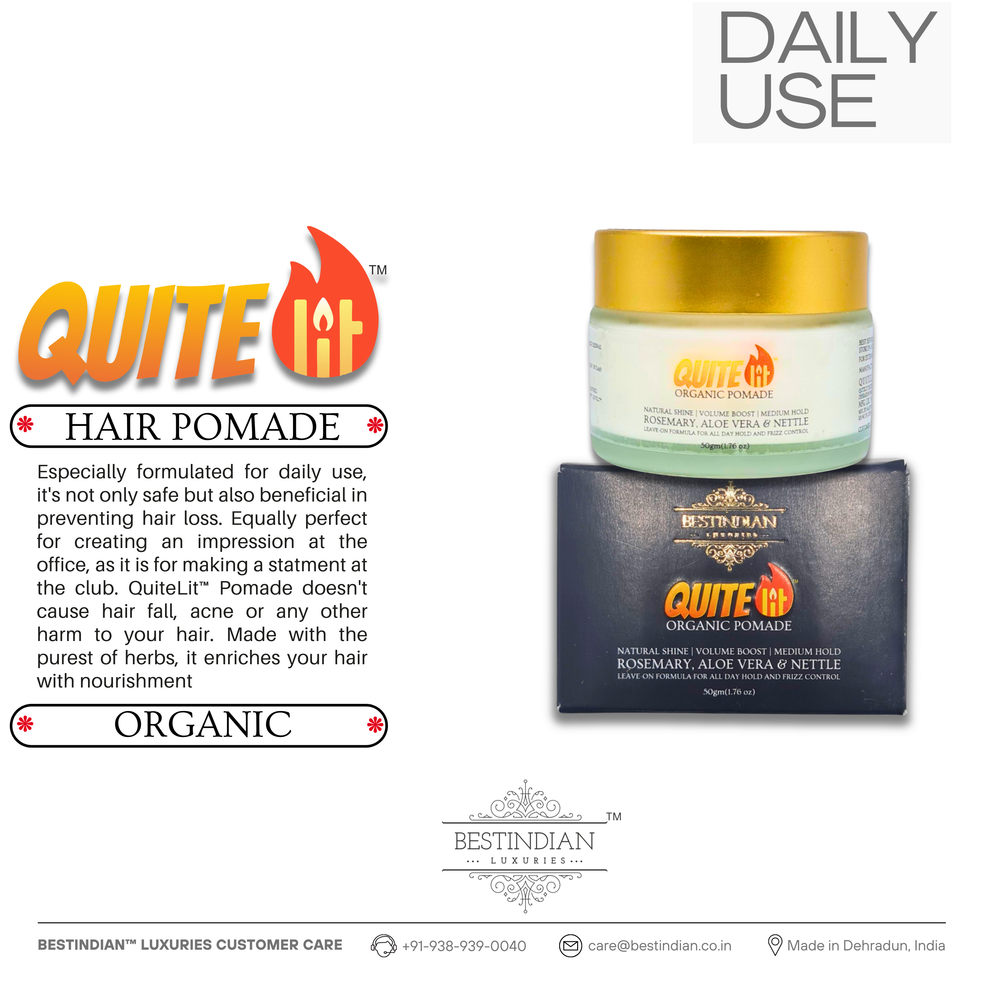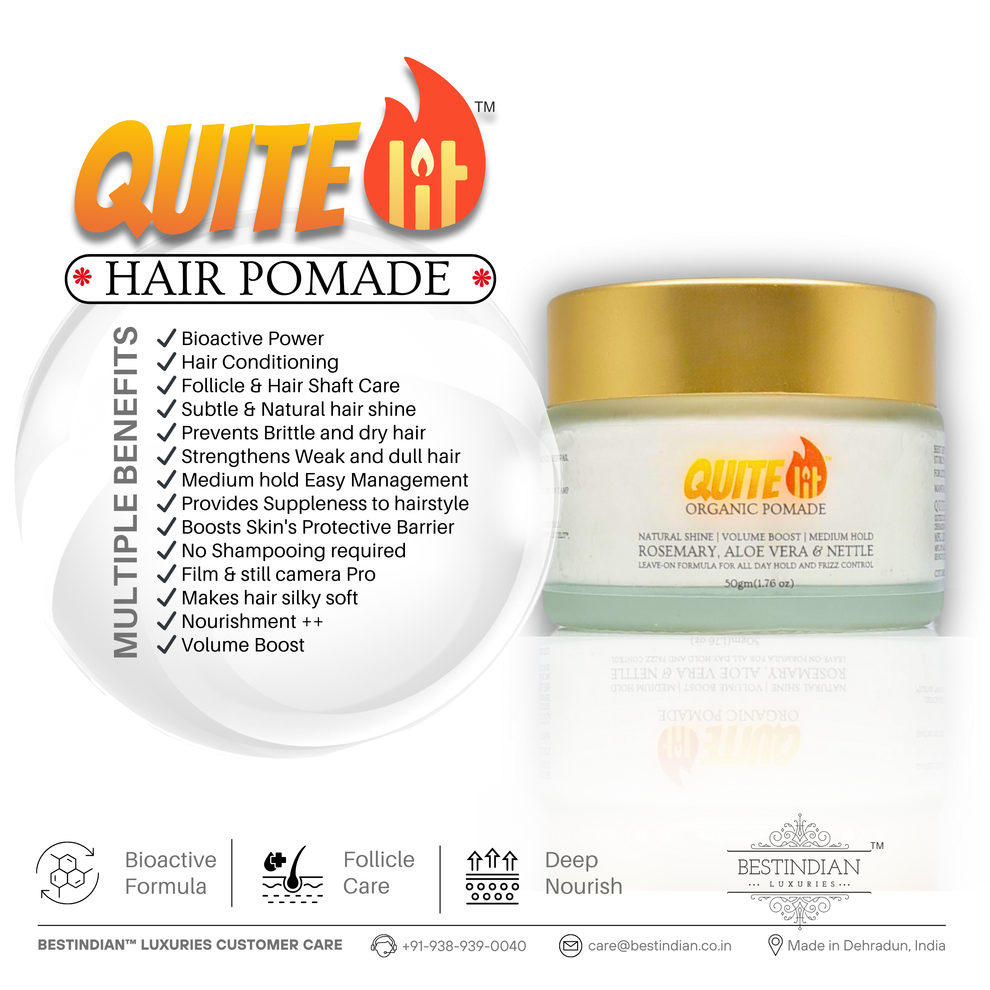BestIndian
QuiteLit™ Organic Hair Pomade | Natural Styling for Men & Women
QuiteLit™ Organic Hair Pomade | Natural Styling for Men & Women
Couldn't load pickup availability
Define your style with confidence and care. Tired of styling products that rely on harsh chemicals, leaving your hair stiff, greasy, or full of residue? The QuiteLit™ Natural Hair Pomade is your solution. Crafted with nourishing Beeswax, Jojoba Oil, and herbal extracts, our water-based formula offers a dependable medium hold and a healthy, natural shine. It allows you to sculpt, texturize, and control frizz while keeping your hair touchably soft and actively supported. The ultimate tool for achieving sophisticated hairstyles without compromising on hair health.
⚜️ Certified Organic Ingredients • Chemical-Free Formula • Cruelty-Free • Made in the Himalayas
Please Note: Conscious Archive Item (60% Off)
- Manufacturing Date: January 2024
- Best Before: January 2026
- This item is part of our Conscious Archive Sale and is offered at an exceptional 60% discount due to its approaching best before date. It is final sale.
Share
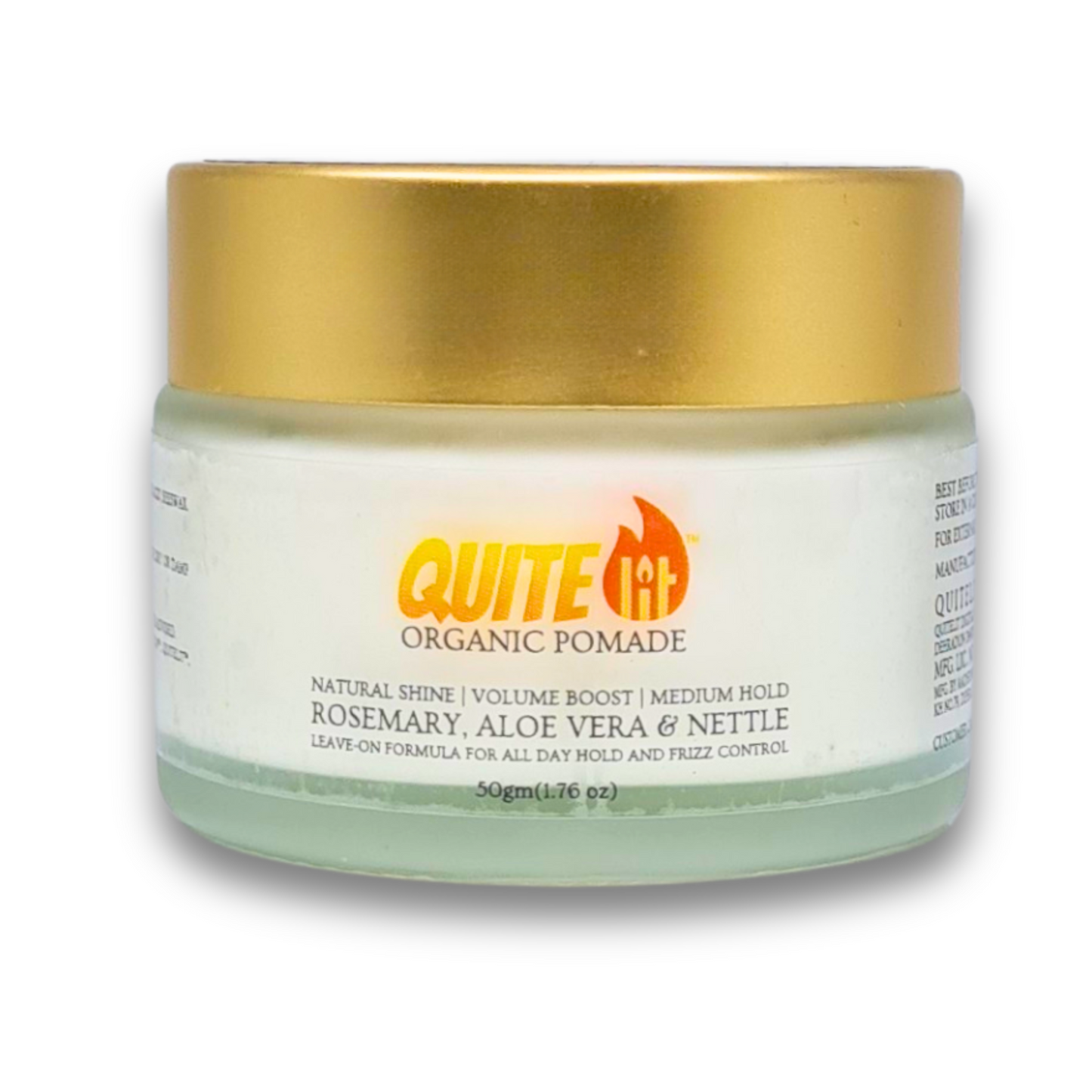
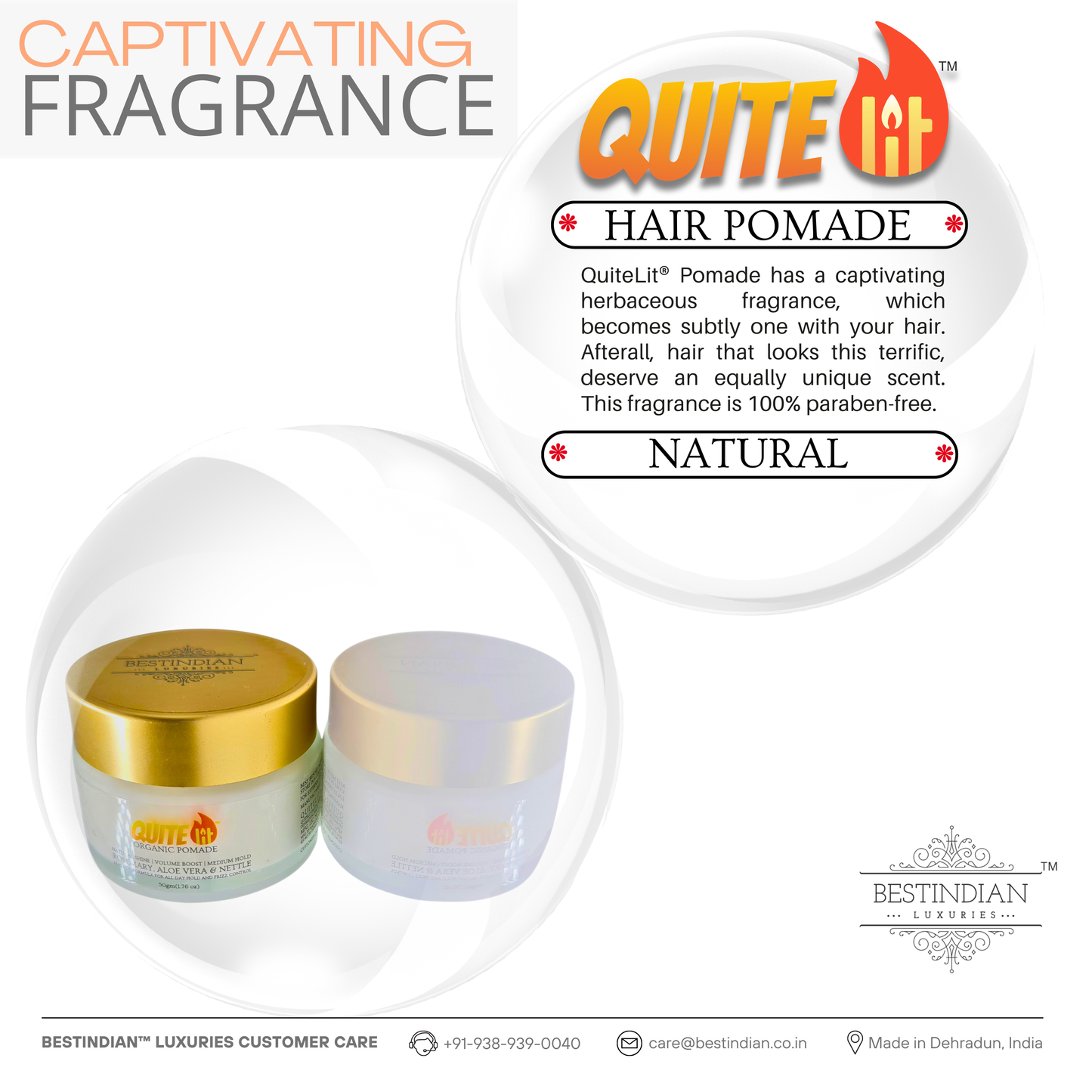

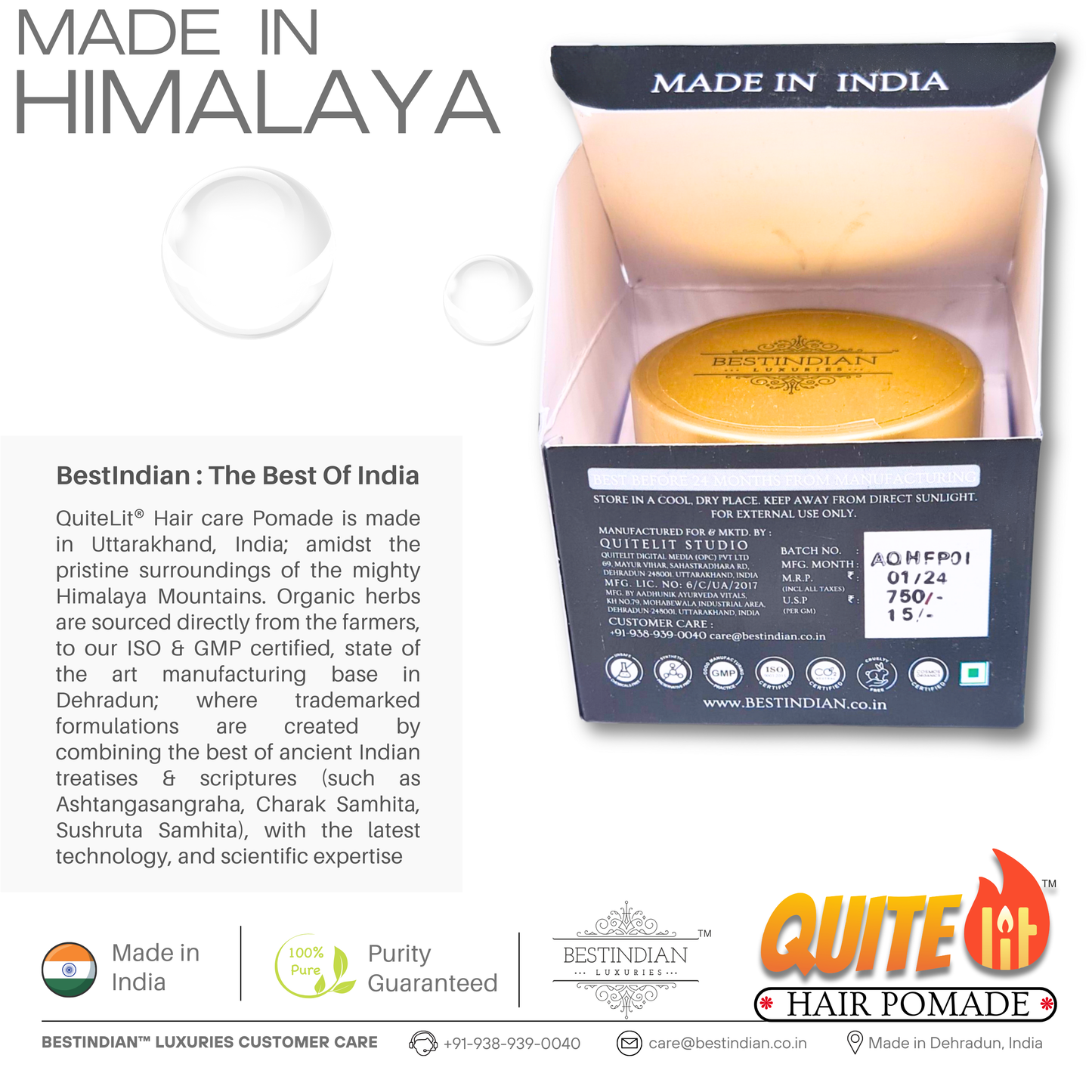

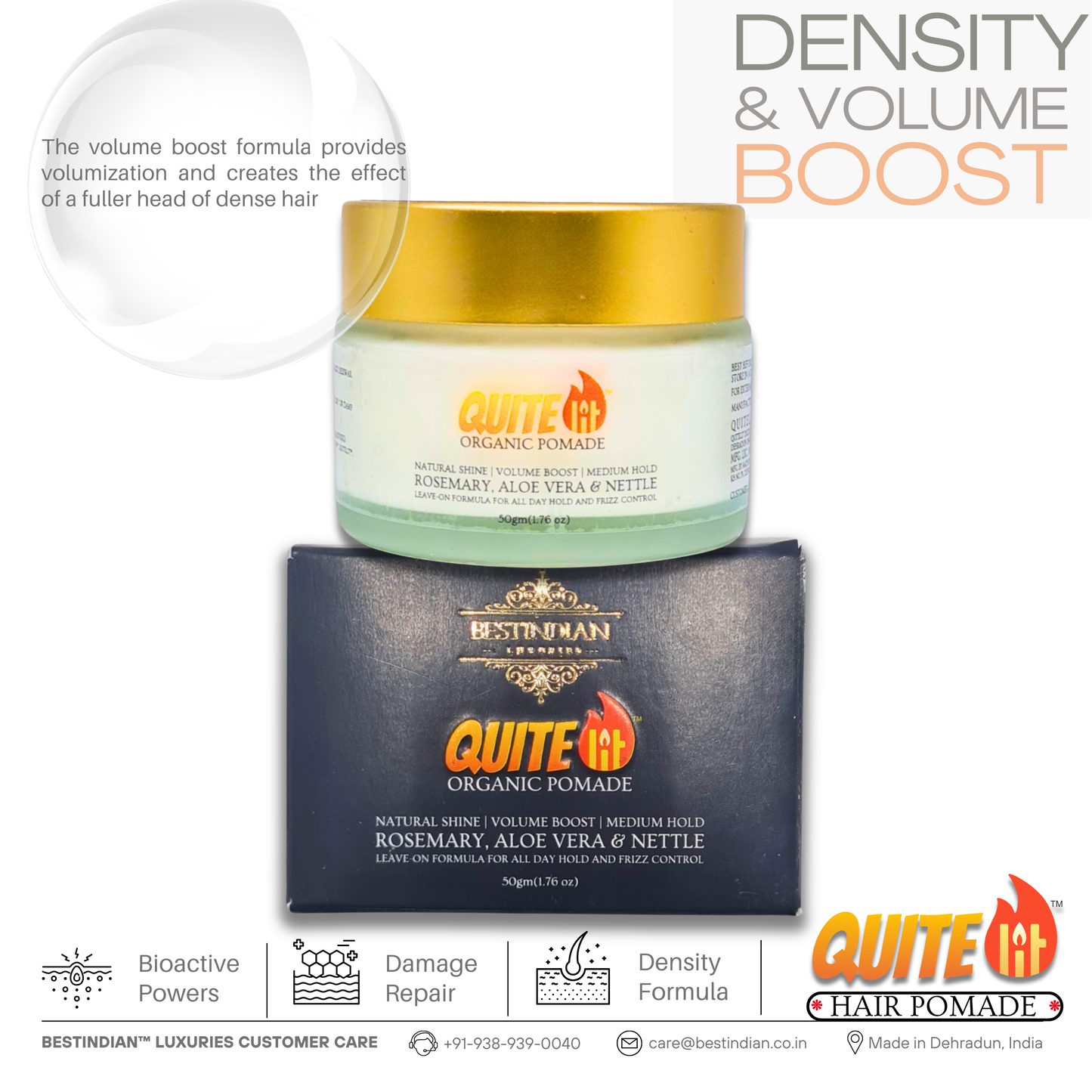

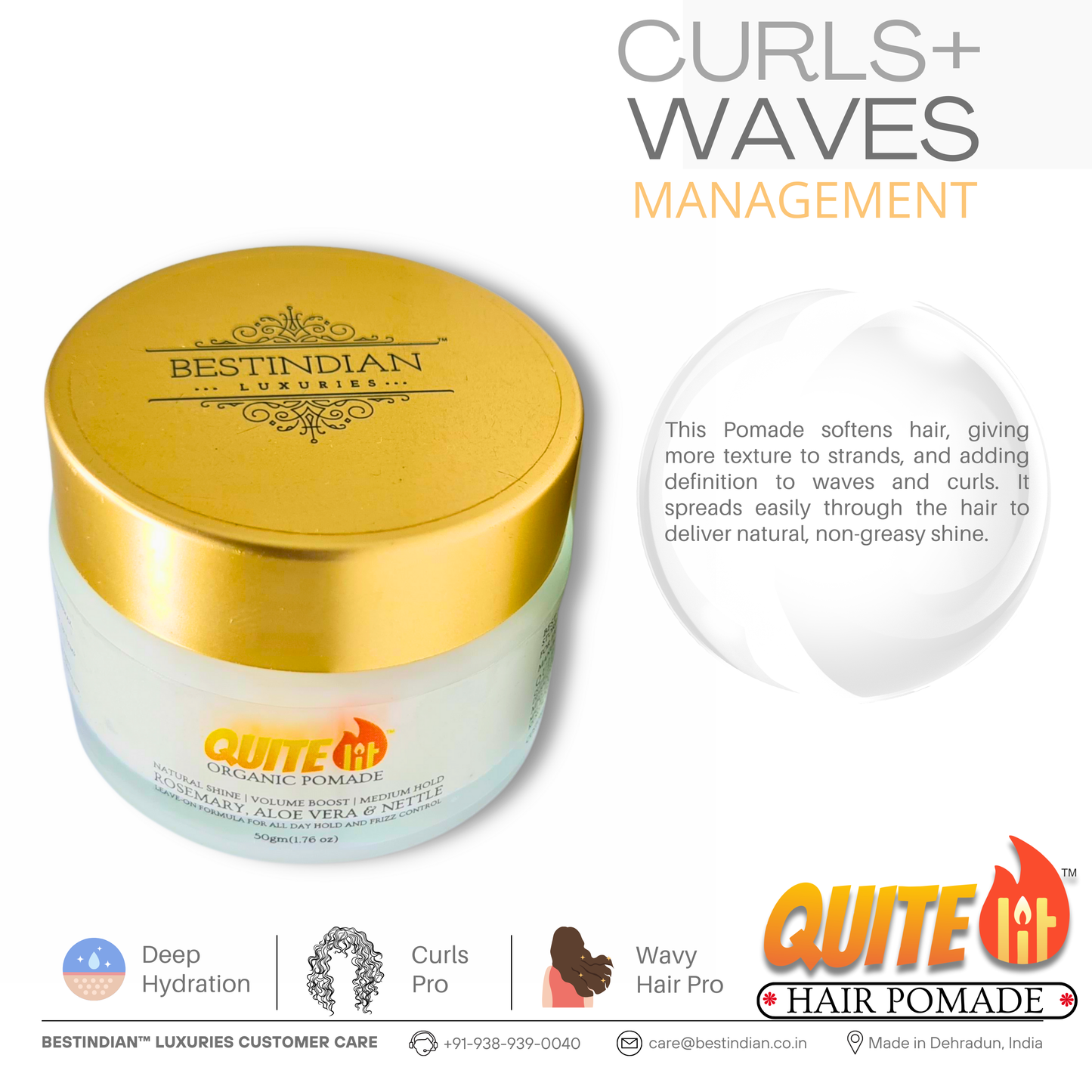
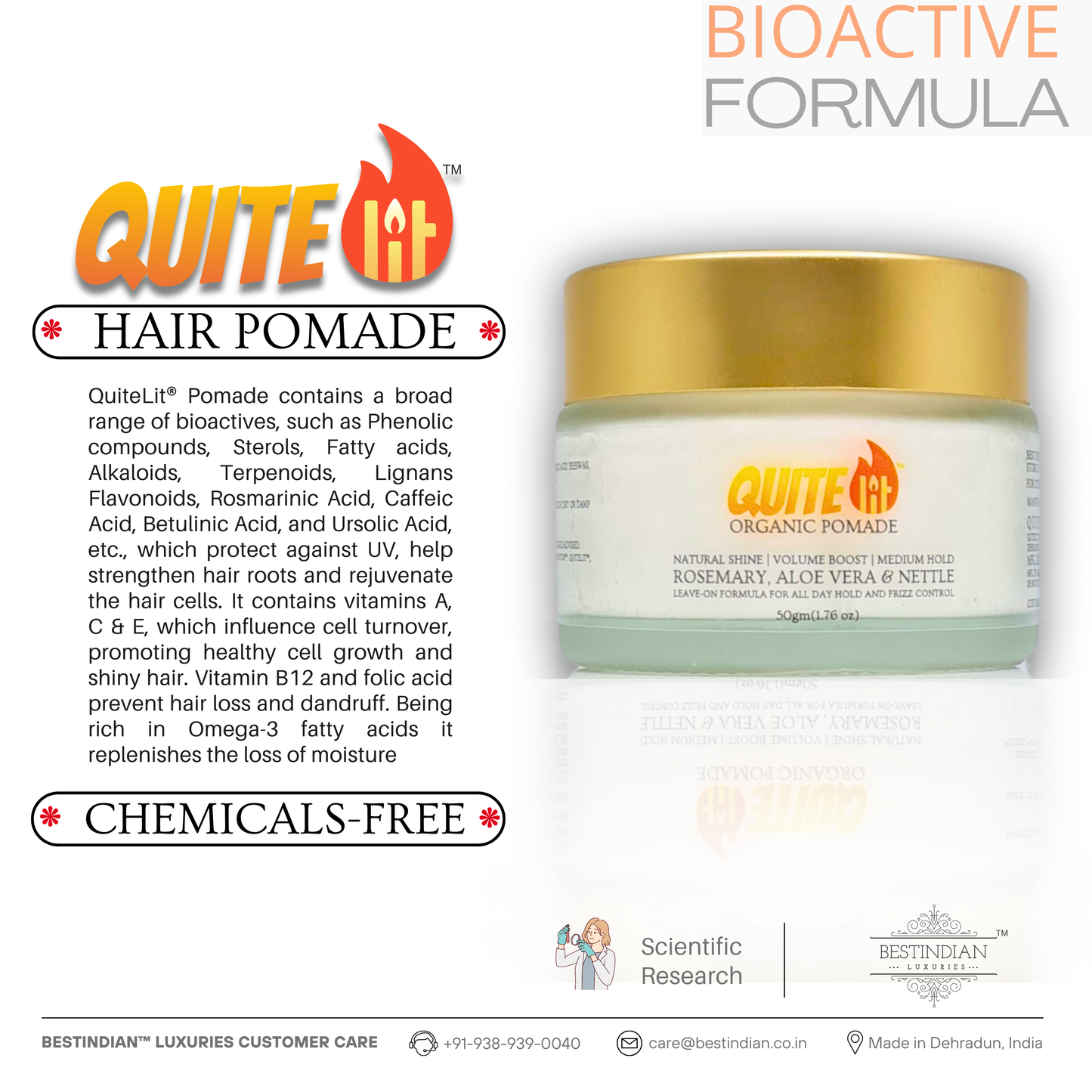
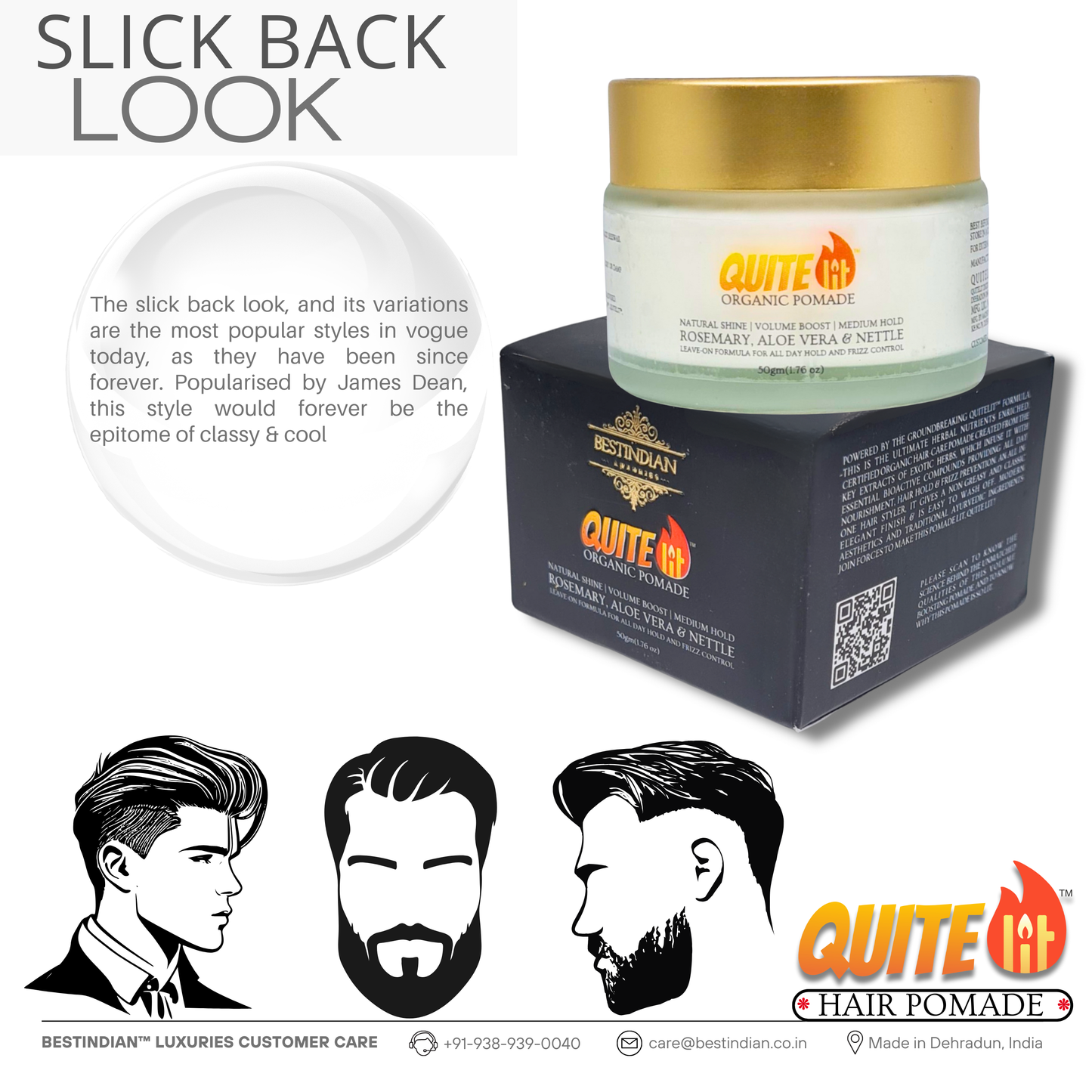

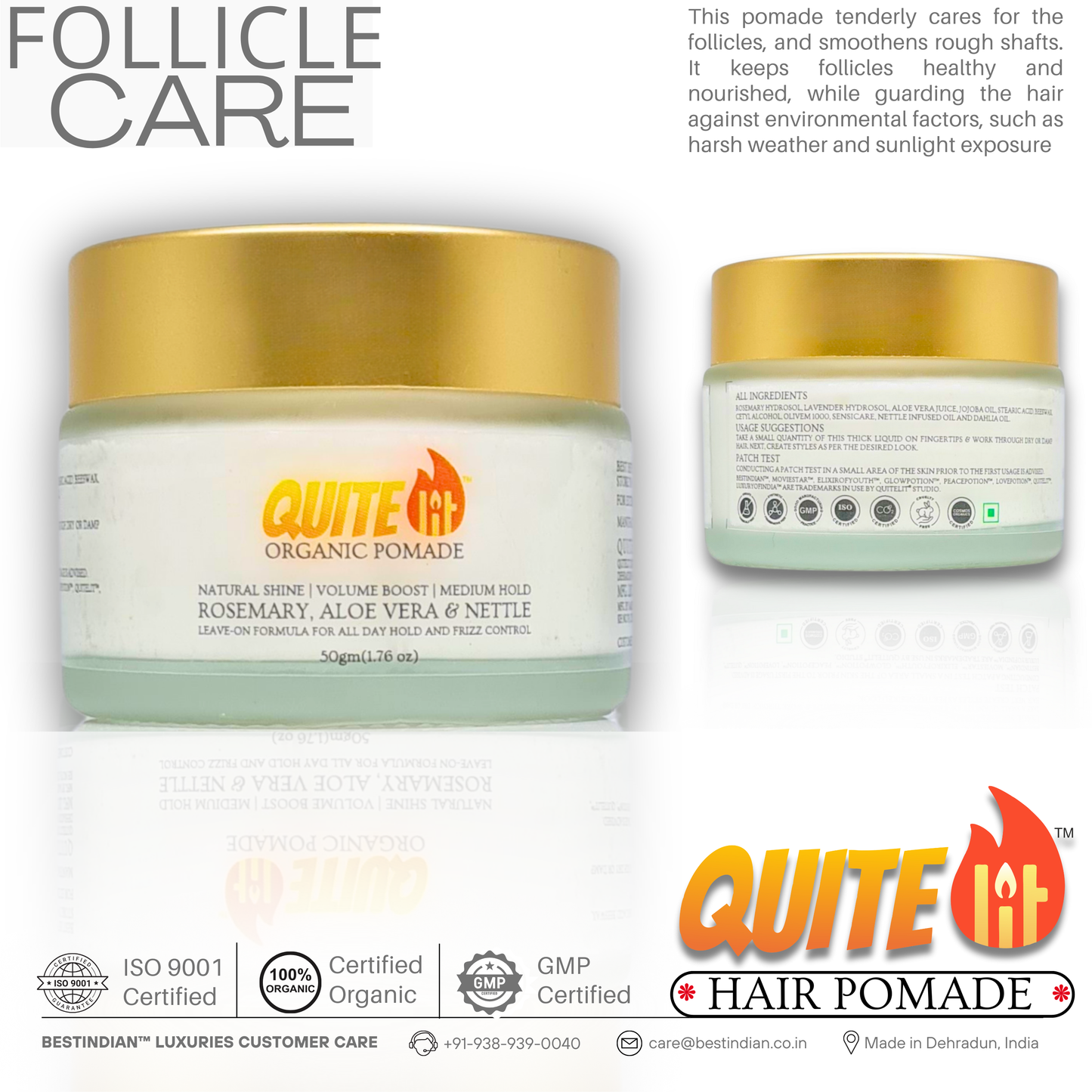
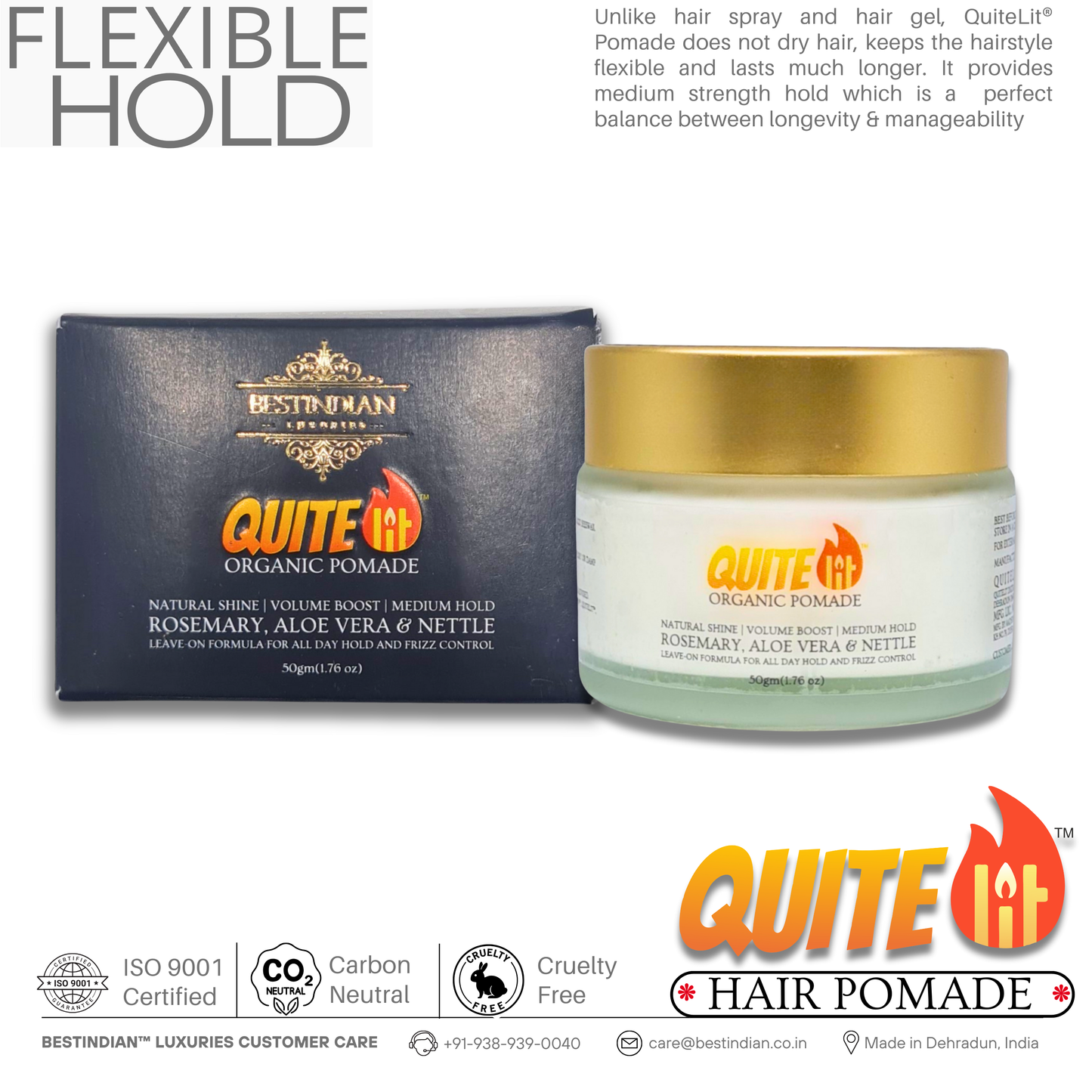
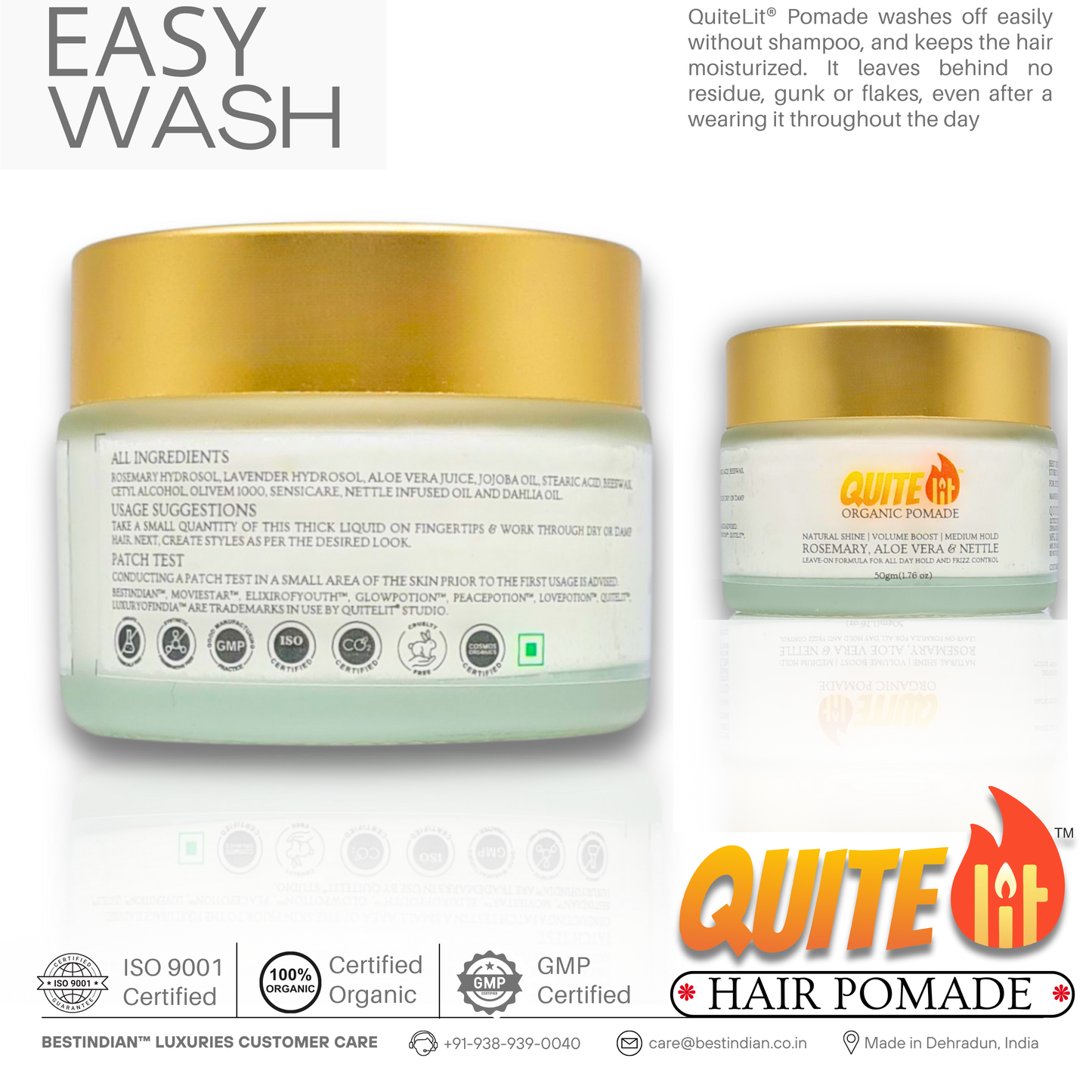
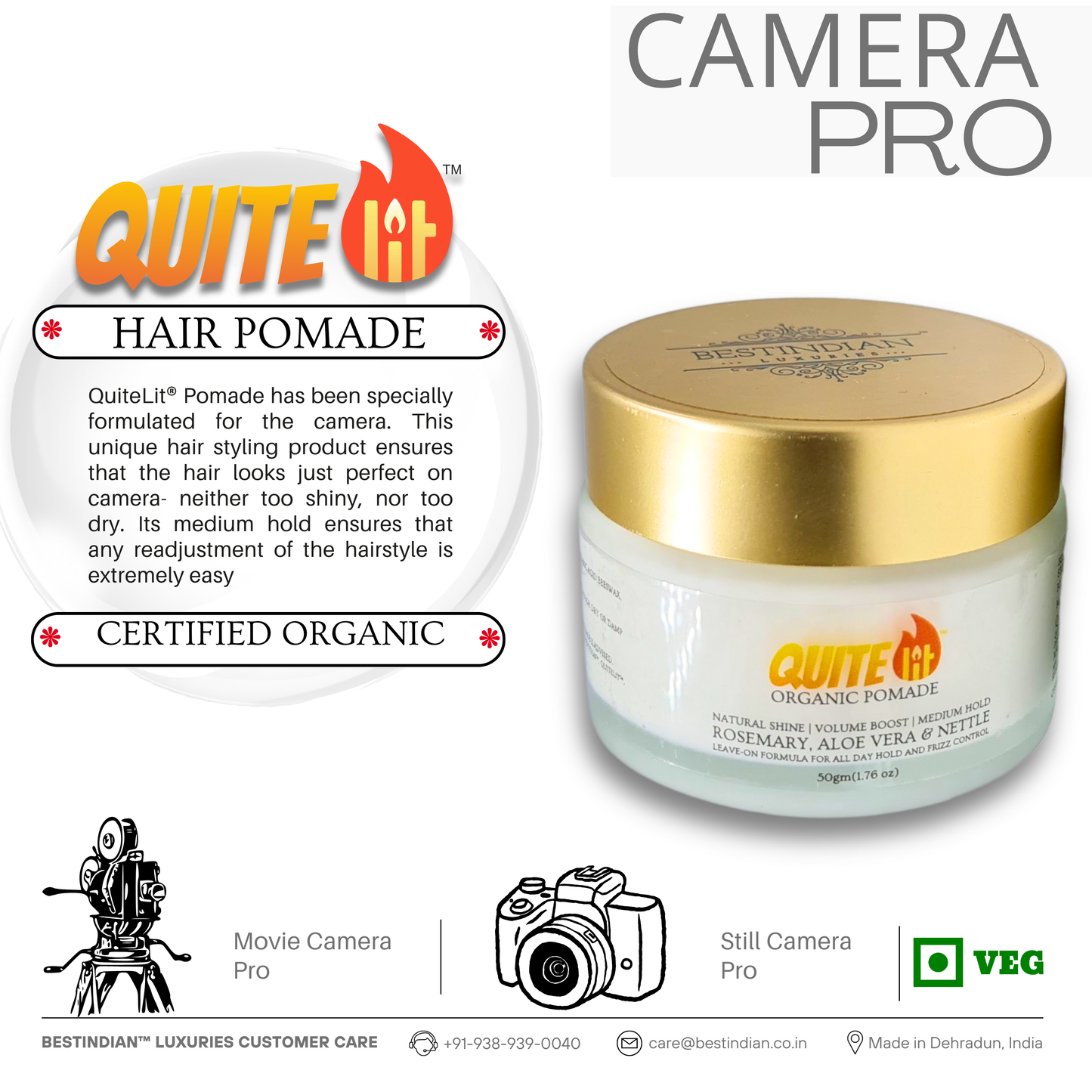
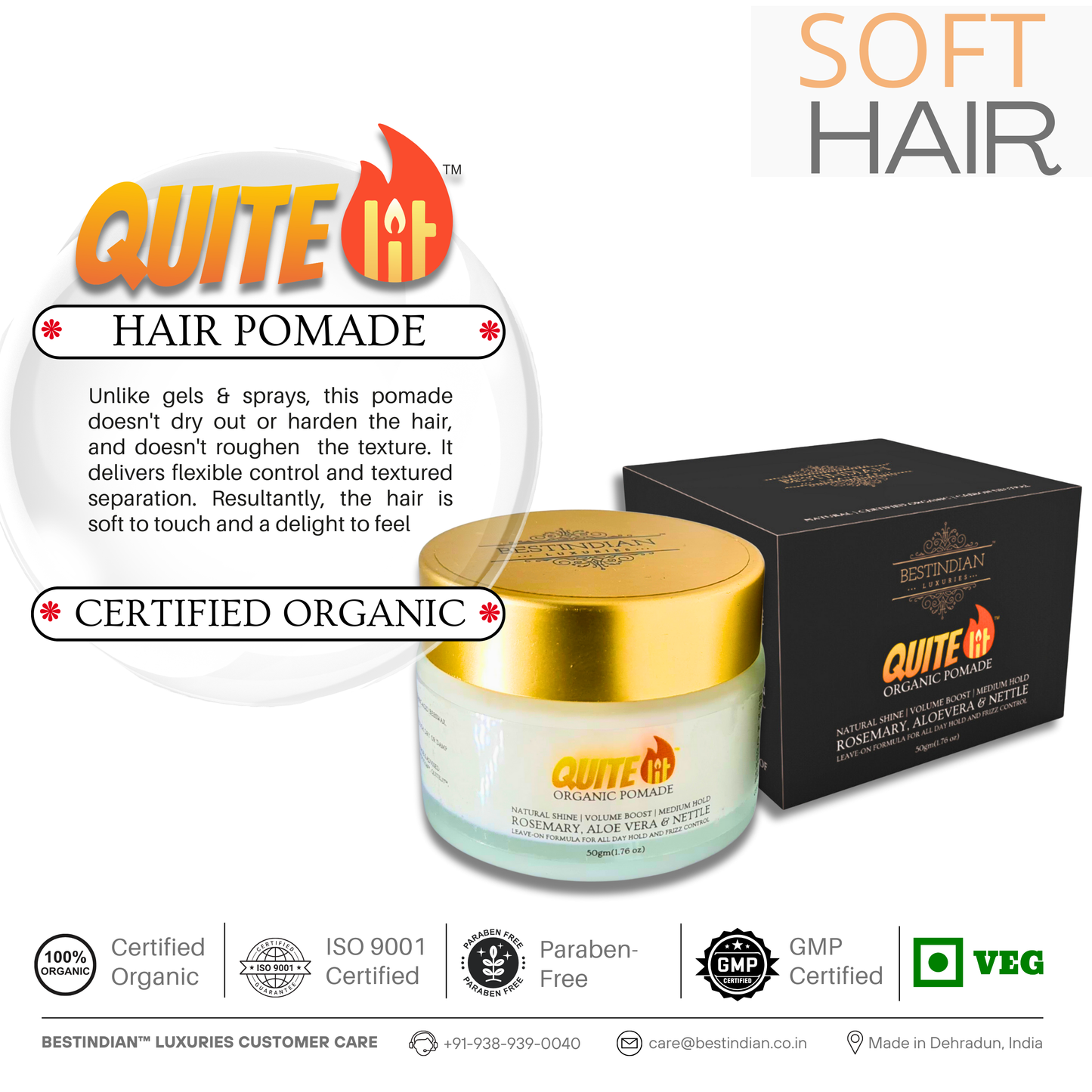
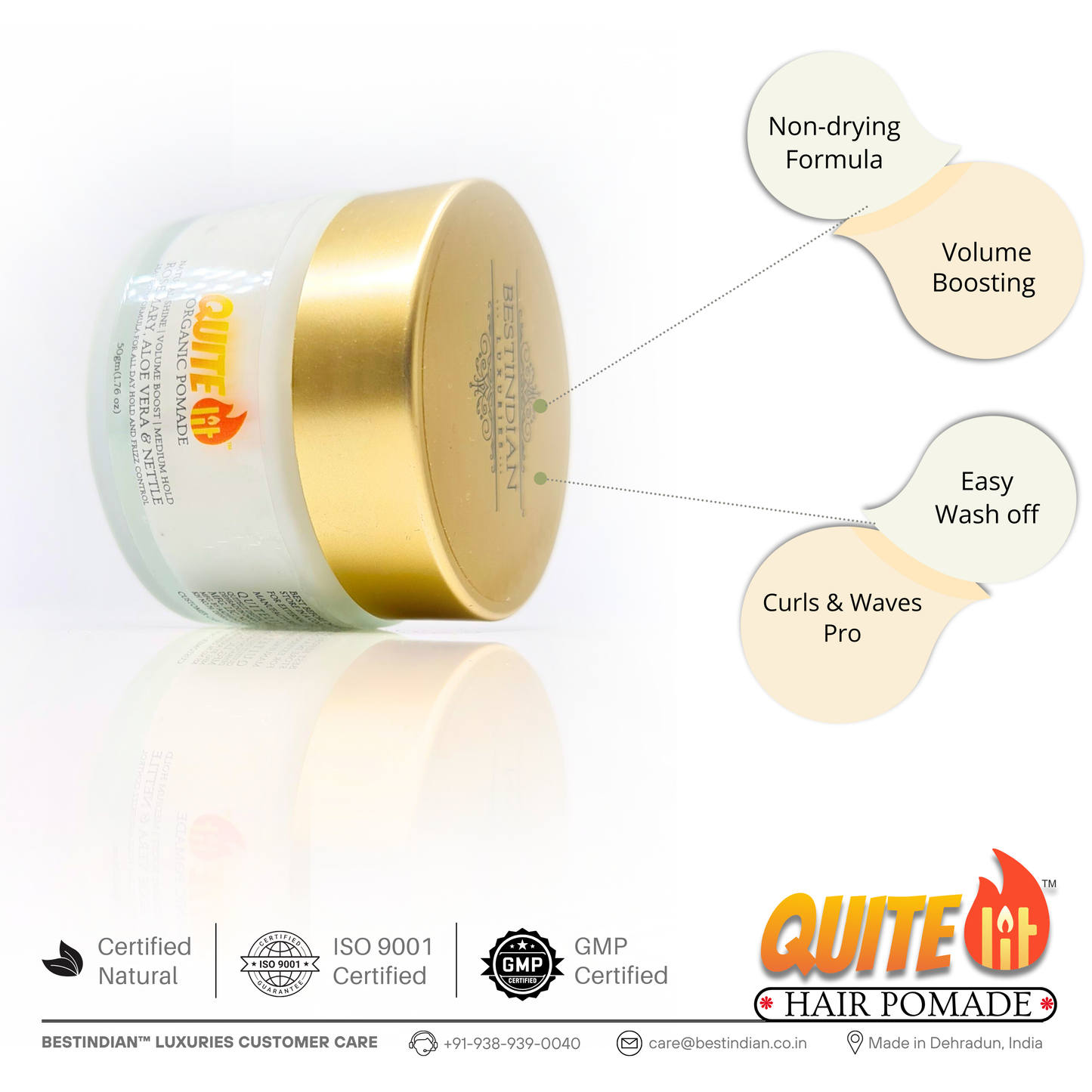
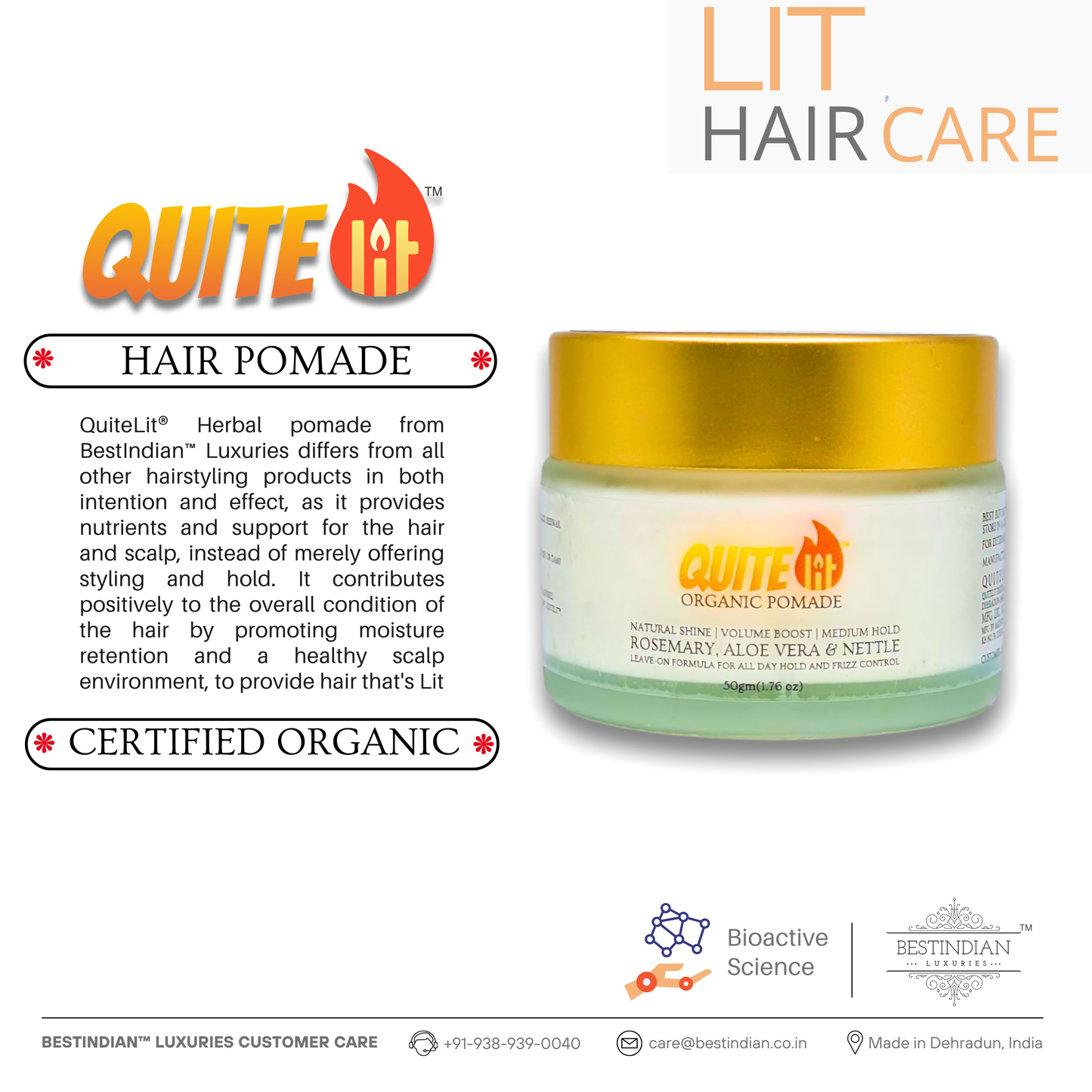

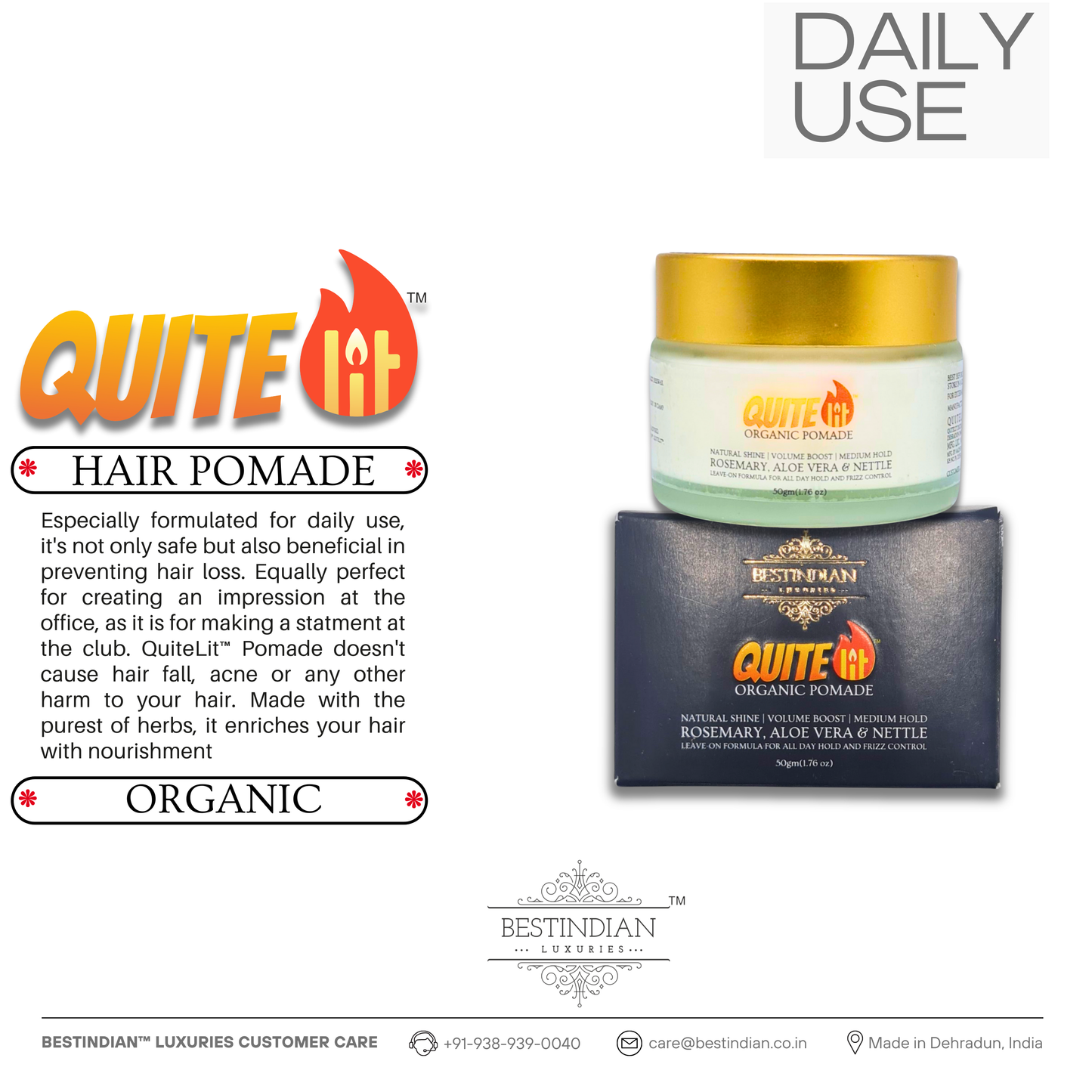
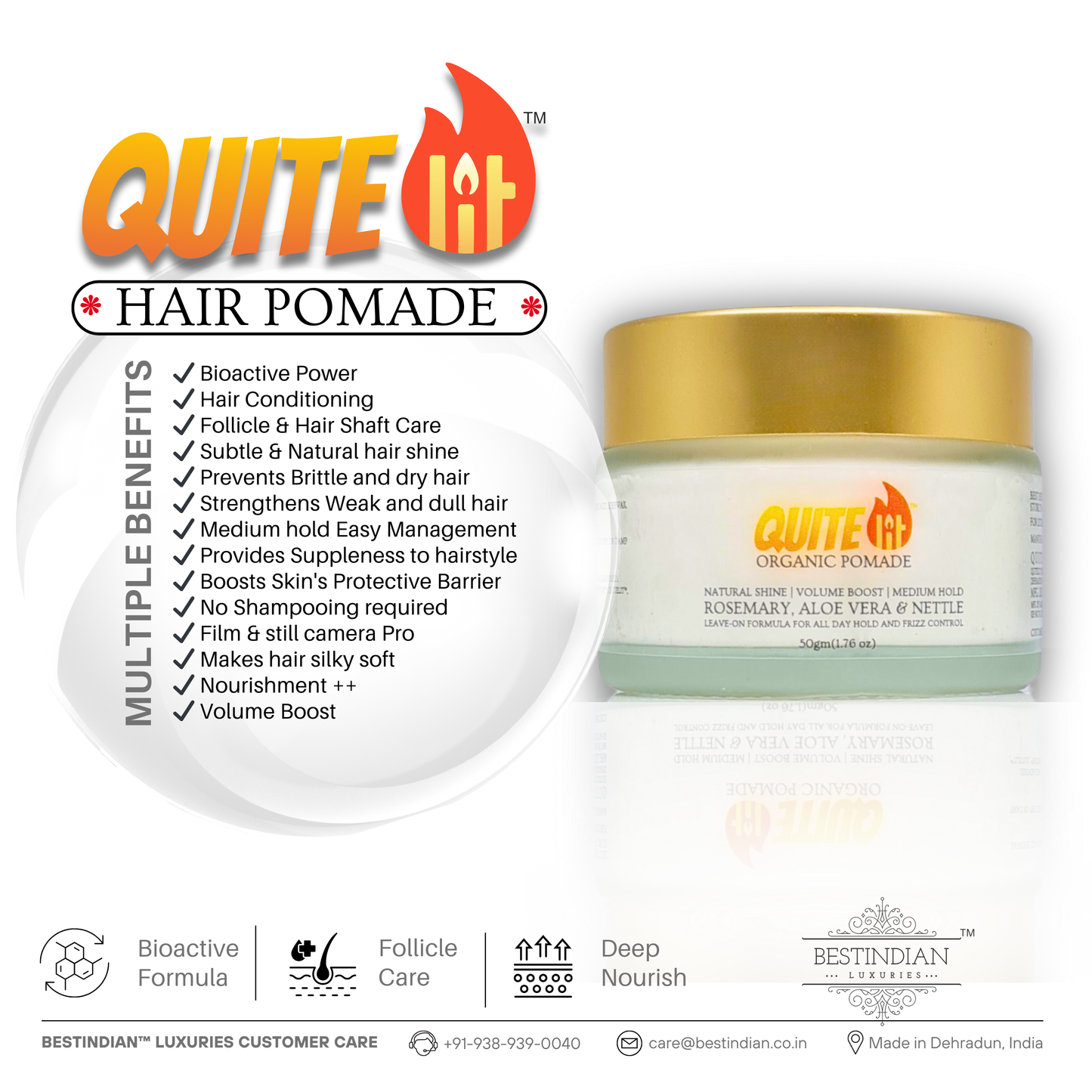
BESTINDIAN LUXURIES
The Finer Details
Why You’ll Love It
Elevate your styling routine with QuiteLit™ — the organic pomade that defines, nourishes & protects every day.
VERSATILE HAIR STYLING POMADE
⚜️ From Sleek to Tousled: Whether you're crafting a sharp, professional slick-back or a relaxed, textured look, this pomade provides the pliable control you need. Its unique formula works equally well for achieving a wet, shiny finish or a more subtle, matte appearance.
EFFECTIVE POMADE FOR FRIZZY HAIR
⚜️ All-Day Frizz Control: Powered by natural moisturizers like Aloe Vera and Jojoba Oil, our formula helps to smooth the hair cuticle to block humidity. It provides a polished, flyaway-free finish that lasts, without weighing your hair down.
TRULY CHEMICAL FREE POMADE
⚜️ Nourish as You Style: Unlike conventional products that rely on petroleum or parabens, QuiteLit™ is formulated with organic and herbal ingredients. Style your hair daily, knowing you are using a product that is safe for your hair and scalp, and won't cause buildup, flakes, or irritation.
EASY WASH WATER BASED POMADE
⚜️ Effortless Application & Removal: The water-based formula is incredibly easy to work with and distributes evenly through hair. Best of all, it rinses out cleanly with just water, often without needing extra shampoo, leaving zero residue behind.
Style with confidence, nourish with care. QuiteLit™ Organic Hair Pomade combines medium hold, frizz control, and natural shine in a water-based, chemical-free formula that’s safe for daily use on all hair types.
USP
⚜️ Medium, flexible hold — never stiff or crunchy
⚜️ Frizz control + natural, non-greasy shine
⚜️ Water-based & easy wash-off, no residue
⚜️ Organic herbs & oils: Aloe Vera, Jojoba, Rosemary, Nettle
⚜️ Safe for men & women, all hair types & textures
All Benefits
The QuiteLit™ Organic Hair Pomade is more than a styling aid — it’s a daily treatment that nourishes while defining your look. Engineered with organic herbs and natural oils, it delivers flexible hold, frizz control, and healthy shine for all hair types.
Versatile Styling & Flexible Control
⚜️ All-Day Hold That Moves With You – Powered by natural Beeswax, this pomade offers dependable medium hold while staying soft, flexible, and easy to restyle. No stiffness, no crunch.
⚜️ Adaptable Finish for Any Style – Its water-based formula gives you full versatility. Create a sleek, high-shine “wet look” on damp hair or a textured, matte finish on dry hair.
⚜️ Soft, Touchable Texture – Unlike alcohol-based gels that dry and flake, our natural oil blend keeps hair conditioned, silky, and pleasant to the touch.
Enhanced Hair Health & Appearance
⚜️ Frizz & Flyaway Control – Infused with Jojoba Oil, it smooths the cuticle, tames humidity-driven frizz, and disguises split ends for polished styling.
⚜️ Volume-Boosting Effect – Lightweight texture lifts from the roots, creating natural fullness and density without weighing hair down.
⚜️ Works on Every Hair Type – Designed for men and women, this pomade adapts seamlessly to straight, wavy, curly, fine, or thick hair.
Purity, Comfort & Scalp Health
⚜️ Certified Organic & Chemical-Free – Crafted with Aloe Vera, Rosemary Hydrosol, and herbal actives, free from parabens, sulfates, and synthetic irritants. Gentle on scalp and safe for daily use.
⚜️ Effortless Wash-Off – Being water-based, QuiteLit™ rinses out cleanly with just water, leaving no residue, flakes, or gunk that can clog follicles.
⚜️ Soothes & Protects – Herbal extracts provide natural antimicrobial and soothing properties, making it ideal for everyday styling without scalp irritation.
✨ QuiteLit™ — the organic, water-based hair pomade that styles, nourishes & protects daily.
Your Ritual & Care
How to Use: The Styling Ritual
Achieve your desired look with this simple, professional-grade ritual. A little goes a long way, so begin with a small amount and add more only if necessary.
- Start Fresh: For best results, apply to clean, towel-dried, and slightly damp hair. The pomade is activated by a small amount of moisture and adheres best to clean hair shafts.
- Emulsify: Scoop a small, dime-sized amount onto your fingertips. Rub your palms and fingers together to warm and evenly distribute the product until it is smooth.
- Apply to Roots First: Work the pomade into the base of your hair first. This is the key to controlling your style's direction and building volume from the ground up.
- Distribute Evenly: Ensure the product is applied all around your head—top, sides, and back—for a uniform look and hold. Comb through to distribute any excess from the base along the strands.
- Style as Desired: Sculpt, texturize, or smooth your hair into its final shape. Use it to define layers in long hair, create spikes in short hair, or achieve a sharp slick-back. For added longevity and lift, you can set your style with a blow dryer.
When to Use
⚜️ Use daily to style your hair for any occasion, from a professional workplace setting to a night out. Its natural formulation is safe for frequent use and helps protect hair from daily environmental stressors.
Who Should Use
- ⚜️ Formulated for all hair types, lengths, and textures, for both men and women.
- ⚜️ Particularly effective for those seeking to control frizz, add volume to fine hair, define curls, or achieve a polished style without harsh chemicals.
- ⚜️ Ideal for anyone wanting a styler with a pliable hold that can be reshaped throughout the day.
Care Suggestions
- ⚜️ Store in a cool, dry place away from direct sunlight.
- ⚜️ For external use only. We recommend a patch test prior to first use.
Apply a dime-sized amount of our natural pomade to clean, damp hair, starting at the roots, to achieve long-lasting medium hold, volume, and frizz control for any hairstyle.
Complete Your Natural Styling Ritual
- ⚜️ Discover Natural & Ayurvedic Hair Care for Indian Hair
- ⚜️ Discover the Best Indian hair Serum
- ⚜️ Read the Definitive Guide to Pure, Safe & Effective Chemical-Free Products
Fragrance
A Captivating, Nature-Derived Scent
The QuiteLit™ Pomade features a sophisticated and pleasant fragrance profile derived entirely from natural botanicals. Unlike synthetic perfumes that can be overpowering or cause irritation, our scent is designed to be a subtle, elegant backdrop to your style.
⚜️ Dahlia (The Heart Note):
At the core of this fragrance is the essence of Dahlia. This provides a captivating, clean, and subtly floral aroma that is both modern and timeless. It ensures your hair doesn't just look and feel good, but also smells terrific throughout the day.
⚜️ Rosemary & Lavender (The Foundation):
The base of the pomade is built on pure Rosemary and Lavender hydrosols, which lend a fresh, herbaceous undertone. This complements the Dahlia and adds to the overall clean, natural sensory experience.
Features a captivating and pleasant natural fragrance with a heart of Dahlia, grounded by fresh, herbaceous notes from Rosemary and Lavender hydrosols.
Ingredient Transparency
Our Promise of 100% Transparency
At BestIndian™, we believe you have a right to know exactly what you are putting on your hair and scalp. We practice absolute transparency, guaranteeing that no other ingredient, apart from those listed below, has been used in this formula. Our commitment is to pure, potent, and honest hair care.
Full Ingredient List (INCI)
Rosmarinus Officinalis (Rosemary) Leaf Water, Lavandula Angustifolia (Lavender) Flower Water, Aloe Barbadensis (Aloe Vera) Leaf Juice, Simmondsia Chinensis (Jojoba) Seed Oil, Stearic Acid, Cera Alba (Beeswax), Cetyl Alcohol, Cetearyl Olivate (and) Sorbitan Olivate, Caprylyl Glycol (and) Phenoxyethanol (and) Sorbic Acid, Urtica Dioica (Nettle) Leaf Extract, Dahlia Variabilis Flower Oil.
Ingredient Deep Dive
Our formula is powered by a synergistic blend of nature's most effective botanicals:
⚜️ Rosemary (Rosmarinus Officinalis): The Root Strengthener
This invigorating herb is rich in bioactive compounds like Rosmarinic Acid. It is known to help strengthen hair roots, protect against environmental stressors, and rejuvenate hair cells for a healthier appearance.
⚜️ Nettle (Urtica Dioica): The Shaft Fortifier
A traditional powerhouse packed with phytochemicals and minerals. Nettle is widely used in hair care for its ability to strengthen the hair shaft, helping to manage and prevent the appearance of hair fall.
⚜️ Aloe Vera (Aloe Barbadensis Miller): The Master Moisturizer
Containing a wealth of vitamins (A, C, E, B12), Aloe Vera contributes to healthy cell turnover for shiny hair. Its potent moisturizing properties directly help in managing the appearance of both hair fall and dandruff.
⚜️ Jojoba Oil (Simmondsia Chinensis): The Natural Conditioner
This unique oil closely mimics the scalp's natural sebum, allowing it to provide lightweight moisture and shine without clogging pores or weighing hair down, leaving hair feeling soft and conditioned.
Together, these potent botanicals deliver a complete solution: strengthening the foundation, fortifying the hair strand, and smoothing the surface for resilient, perfectly styled hair.
Formulated Without
Parabens, Sulfates, Phthalates, Silicones, Petroleum, Synthetic Chemicals, and Mineral Oil.
A transparent, certified organic and herbal formula featuring Rosemary to strengthen, Nettle to fortify, Aloe Vera to moisturize, and Jojoba Oil to condition.
Frequently Asked Questions
1. Is this pomade suitable for daily use?
⚜️ Yes. QuiteLit™ Organic Hair Pomade is crafted with herbal, organic ingredients and is completely free from harsh synthetic chemicals. It’s gentle on the scalp and safe for daily styling without causing damage.
2. Will this pomade make my hair look greasy or oily?
⚜️ Not at all. This lightweight, water-based hair pomade provides a natural, healthy shine without greasiness. For a matte finish, simply apply it on dry hair.
3. What is the difference between this pomade and a hair gel?
⚜️ Unlike gels that rely on synthetic polymers for a stiff, crunchy hold, QuiteLit™ Pomade offers a pliable, touchable hold with a natural finish. It won’t flake and feels soft thanks to natural waxes and oils.
4. How strong is the hold?
⚜️ It provides a dependable medium hold — strong enough to keep most hairstyles in place all day, yet flexible enough for natural movement and restyling.
5. Is it difficult to wash out?
⚜️ No. As a water-based pomade, QuiteLit™ rinses out effortlessly with water, often without extra shampoo. It leaves no residue, buildup, or flakes.
6. Can women use this hair styling pomade?
⚜️ Absolutely. This unisex hair pomade works for both men and women. It helps manage frizz, tame flyaways in buns or ponytails, and define layers in short or long hair.
7. Will a water-based pomade work on thick or curly hair?
⚜️ Yes. QuiteLit™ water-based pomade is highly effective for curly or thick hair. It defines curls, adds texture, and tames frizz without stiffness or heaviness.
8. Can hair pomade cause hair fall?
⚜️ Conventional pomades with petroleum or harsh chemicals may clog follicles and contribute to hair fall. QuiteLit™ uses gentle, non-comedogenic botanicals like Jojoba Oil and Aloe Vera, supporting scalp health and minimizing hair fall risk.
9. Is the fragrance in this pomade natural?
⚜️ Yes. Its captivating Dahlia-inspired fragrance comes from natural botanical oils and hydrosols — never synthetic perfumes.
10. How much pomade should I use for my hair?
⚜️ Start with a small, dime-sized amount. A little goes a long way, and you can adjust depending on your hair type, length, and desired style.
11. Can I use a blow dryer with this product?
⚜️ Yes. For added lift, volume, and stronger hold, apply the pomade to damp hair and then style with a blow dryer.
12. Is this pomade vegan?
⚜️ This formula contains natural Beeswax, so it is vegetarian and cruelty-free, but not fully vegan.
QuiteLit™ Organic Hair Pomade — safe for daily use, non-greasy, water-based, and effective for men and women across all hair types.
The Science & Sensory Experience
The Science & Sensory Experience
Frizz and stiffness often result from harsh chemical stylers that strip the hair's natural defenses. Our science-led, water-based formula addresses this by delivering nourishing Beeswax and Jojoba Oil to provide a pliable, all-day hold without the use of stiff synthetic polymers. This unique blend helps smooth the hair cuticle to effectively block humidity and control frizz. Experience its lightweight, non-greasy texture that leaves hair feeling conditioned and touchably soft—never sticky or hard—with a subtle, captivating Dahlia-inspired fragrance.
The Science of Healthy Styling
Daily grooming, environmental exposure, and styling products can compromise the hair's natural defenses, leading to common issues like frizz, breakage, and dullness. Our scientific approach targets these challenges with potent, natural solutions that style effectively while supporting the hair's structural integrity.
⚜️ The Challenge: Frizz & Unmanageable Hair
Healthy, virgin hair has a natural water-repellent (hydrophobic) lipid layer known as 18-MEA. Daily weathering and chemical treatments can strip this layer, making the hair porous and hydrophilic. This increased water absorption causes the hair shaft to swell, leading to cuticle lifting, frizz, and tangling.
⚜️ The Challenge: Breakage & Split Ends
When the protective outer cuticle layer is damaged or removed, the inner cortex is exposed. This weakens the hair fiber, making it susceptible to cracks that can travel up the shaft, resulting in split ends and breakage. This damage is often accelerated by grooming friction and environmental stressors like sunlight.
⚜️ The BestIndian™ Botanical Solution
Our formula addresses these challenges with a multi-pronged approach rooted in botanical science:
- Replenishing Surface Lipids: Natural ingredients like Jojoba Oil are structurally similar to the scalp's own sebum. They help replenish the hair's protective lipid layer, smoothing the cuticle and restoring a more hydrophobic, frizz-resistant surface.
- Reinforcing Cuticle Integrity: We use potent herbal extracts like Nettle, which is traditionally used to strengthen the hair shaft, and Rosemary, which is rich in antioxidants that help protect hair proteins from environmental and free radical damage.
- Preventing Buildup: Our formula is fundamentally different from many stylers because it is water-based. This ensures it rinses out easily and cleanly, preventing the scalp buildup that can clog follicles and lead to irritation. Soothing ingredients like Aloe Vera further support a calm, healthy scalp environment, making it ideal for daily use.
Our formula scientifically addresses styling challenges by using Jojoba Oil to control frizz, Rosemary and Nettle extracts to reinforce hair's integrity, and a water-based formula with Aloe Vera to prevent scalp buildup.
Star Ingredients
-

Rosemary
A stimulating herb rich in antioxidants that helps to invigorate the scalp and strengthen hair from the roots. It protects against UV, helps strengthen hair roots and rejuvenates the hair cells due to its bioactive compounds including Rosmarinic Acid, Caffeic Acid, Betulinic Acid & Ursolic Acid. etc. It replenishes the loss of moisture as it is rich in Omega-3 fatty acids.
-

Aloe vera
Aloe vera contains vitamins A, C & E. All three of these vitamins contribute to cell turnover, promoting healthy cell growth and shiny hair. Vitamin B12 and folic acid are also contained in aloe vera gel which prevent hairfall. It directly controls hair loss and dandruff.
-

Nettle
A mineral-rich botanical traditionally used to fortify the hair shaft, helping to minimize breakage and the appearance of hair fall. Urtica dioica contains a broad range of phytochemicals, such as phenolic compounds, sterols, fatty acids, alkaloids, terpenoids, flavonoids,and lignans. Nettle is used for treating & preventing hair loss by strengthening the hair shaft.
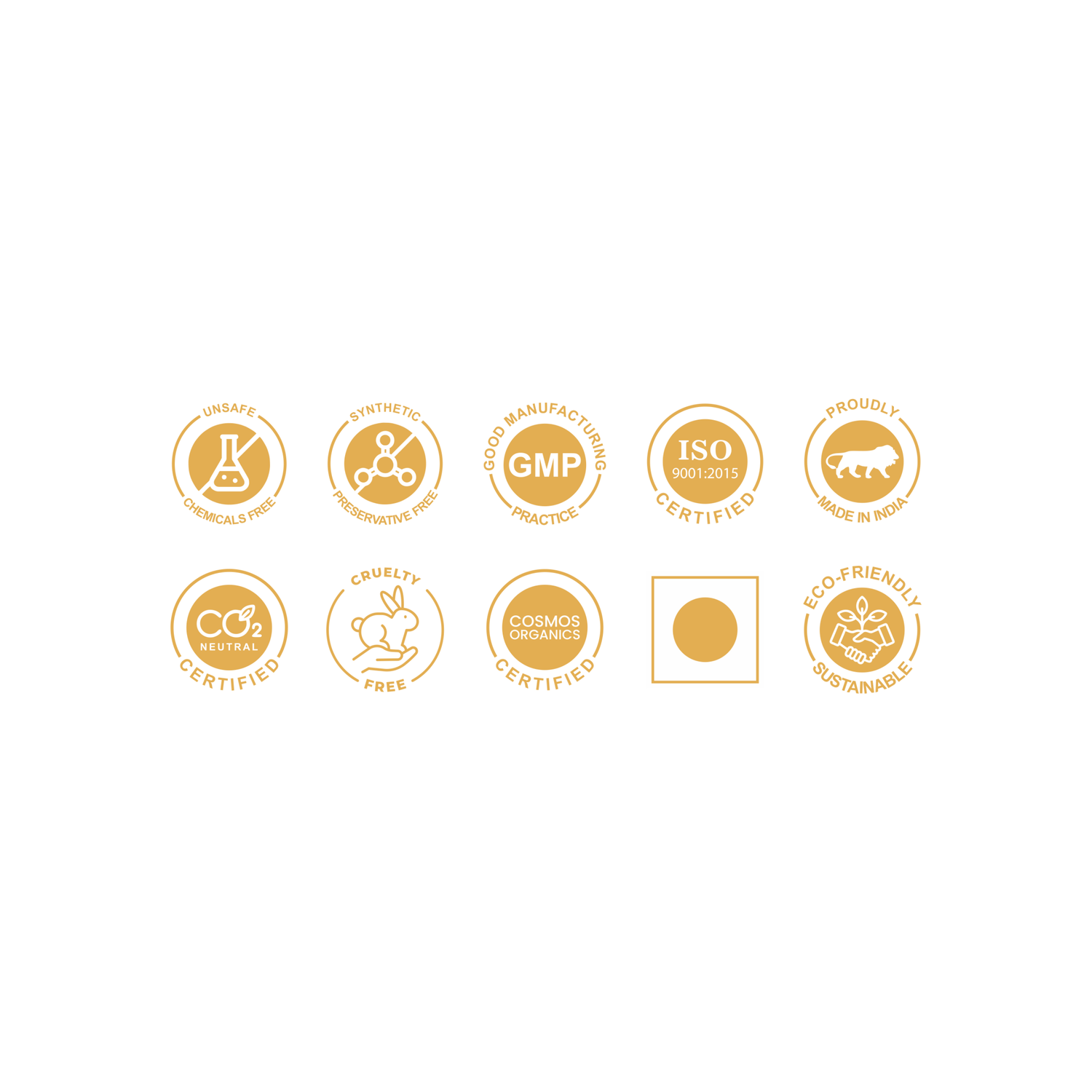
Trust & Transparency
The BestIndian™ Promise
At BestIndian™, we believe luxury is defined by authenticity & efficacy. Our philosophy marries the timeless wisdom of Ayurveda with the precision of modern science. We disclose all ingredients used in every product we make, because your trust is our most valued asset.
⚜️
Our Promise: Formulated with 100% natural and certified organic ingredients. Always free from preservatives, parabens, and sulfates. Vegetarian and vegan friendly. No hidden ingredients.
⚜️
Our Certifications: Manufactured in a GMP, ISO & COSMOS Organic certified, carbon-neutral, cruelty-free facility amidst pollution-free environment of the Himalayas in Dehradun, India
OUR BRANDS
-

Moviestar™ – Luxury Ayurvedic Skincare brand by BestIndian™
Luxury skincare designed for professional actors. Moviestar™ by BestIndian™ is a premium...
-

GlowPotion™ – Natural Ayurvedic Skincare brand by BestIndian™
The pinnacle of beauty is a complexion that requires no makeup to...
-

The Elixir of Youth™ Collection for Anti-Aging & Wrinkle Repair
Welcome to Elixir of Youth™- scientifically created, high-performance Ayurvedic formulations designed by...


